#AND IF ANYONE IS INTERESTED IT IS A CHOICES STYLE GAME SO LIKE INTERACTIVE NOVEL THING CALLED SUPERSTITION BY 13LEAGUES
Explore tagged Tumblr posts
Text
when you just glance at an old media you are considering revisiting and your brain is like “oh my gods? We have to now binge this. This is great! I’m going to spend every second thinking about this!”
#AND IF ANYONE IS INTERESTED IT IS A CHOICES STYLE GAME SO LIKE INTERACTIVE NOVEL THING CALLED SUPERSTITION BY 13LEAGUES#I WOULD RECOMMEND ANY OF HER STORIES!!!! Superstition is great! Throne of Ashes is amazing! Dragon racer is discontinued#BUT DRAGON RACER IS AMAZING TOO! Okay???#I need the fandoms of her stories to grow. Cause like.#I can’t keep writing my own fanfics??? I can’t keep drawing my own fanarts!!! I cannot keep making my own ocs to obsess over!#I mean I CAN. but like I want others to obsess too#But yea. I’m rereading what is available of superstition. Because yesssss
0 notes
Text
Okay, okay, so–
My novel requires a re-write of the 24 chapters I already have done-ish (which aren’t even covering all the plot I have planned)
The final 6-10 chapters (not yet written, just loads of notes) are supposed to be a complete genre-swap
And I have been really into RPG-Maker type games recently
I was thinking… what I have planned as the final arc of my novel would make a fine story to be put into an RPG-Maker style basic RPG
I’m hoping RPG Maker MZ goes on sale sometime soon (maybe when Steam has its next huge sale in general)
Story summarised without spoiling too much:
Player Character (PC) & Player’s Partner (PP) are a happy couple
Evil Mother (EM) kidnaps PP
PP’s Best Friend (BF) accuses PC
PP sends a covert message to forget about them
PC and BF get into fights with each other
PC and BF stake out EM’s house
It looks like EM is brainwashing PP
PC wants to involve police
BF want to break PP out themself
Observation looks like PP is barely hanging on
PC and BF team up
Over-dramatised breakout and subsequent escaping the city
BF concedes that maybe PC is right for PP after all
The three live happily ever after
In the novel writing-notes this includes a non-amorous/ aromantic polycule and obviously none of the characters is straight (I’m a tumblr user after all)
But I figure with the drama, the fighting, the “quest” to rescue PP and everything, it would maybe make a nice little RPG and the way the story is planned for the novel, PP would be bigender (which in a game would mean the player gets to choose whether their Love Interest used “he/him” or “she/her”) and overall it’s just very queer, which could all translate into simple variations being all up to the player (like Player Character’s pronouns, Love Interest’s pronouns, type of relationship, etc.)
And I figure the sprite of the PP would get a drastic change as EM is forcing them to adapt to what she demands rather than allowing PP to be themself
Initially PP looks more androgynous (hence up to the player which pronouns are used) and after the abduction, PP would have hair cut short and forced to conform to the gender binary – I just realised, this is basically a “forced detransition” storyline, because in my OG version PP is she/he nonbinary. oof. yikes.
I’m a writer, not a game-maker or artist, though
I haven’t looked into what a basic RPG Maker game takes but would a storyline like this be of interest for anyone?
I know a few people I could ask to help with GIs and character sprites;
And I think I can figure the rest out, depending on RPG Maker’s UI
As I said, I hope RPG Maker MZ goes on sale sometime soon and that I can figure it out pretty intuitively
I know my storyboard, as a writer I tend to focus on dialogue (aka script), and I already made some notes
I want high customisation at the beginning, like, as a feature, that there are default names but the player can also choose to name the PC and PP, like how the player can pick the characters’ pronouns, because I assume that’d create some more emotional attachement
Default names I intend so far are Aleks and Emory (not related to the novel draft I pull this whole plotline from)
The first few minutes are going to be a “week” of PC interacting with PP and their shared home to also further attachment/ make the player care about the love interest; as well as adding some context on the relationship, giving the player time to figure out controls, etc.
That “first week” is supposed to include some simple choices about interacting with the love interest, emphasising the affection between PC and PP (like “cuddle on the couch”, “share food”, “join for shower”)
And I want to utilise a color filter/ overlay because the ‘secondary perspective’ relevant character is colorblind, which would be signified through that color overlay (also to make POV changes easily recognisable)

#rpg maker#my writing#about my ocs#about my novel#about my writing#Léo wishes they had video editing skills#personal whining
7 notes
·
View notes
Text
Overall, you are on point. Obviously, interactive fiction requires a lot of planning and revision. Even classic fiction writers regularly come back and rewrite earlier chapters of their stories for continuity reasons. And an interactive story with branching, meaningful choices, different mechanics etc.? It's no surprise that RC writers struggle to pull off a series finale.
I think one of the most shining examples of how detrimental RC model can be to the quality of the story right now is SOTCN. If you read the 2-3 chapters once every 2 months, it seems fine, but if you binge read the story now, the plot holes are incredibly obvious. For example, there is a scene in the beginning of season 1 with Amen talking to one of the hunters which seems to clearly suggest they don't know Remmao and his students are dark mages... Until the last update where we find out that no, apparently they knew Remmao was a mage all along. It’s so clear the author only had a very rough outline of the characters, plot points and ideas when the series began. This is why authors come back and rewrite things as the story develops. But RC model doesn't allow for such revisions, resulting in the issues we see.
Some additional thoughts.
Firstly, RC authors are expected to do a lot of work. There are the normal things that you'd expect, like researching the topic, creating the outline of the story and actually writing the chapters for every update, but they also manage the visual aspect of the story (finding references, interacting with the art team, making decisions as to how to allocate resources like the number of cut scenes etc.) AND they do the work of a game designer (figuring out the mechanics, the branching, doing the math). Game designer is actually it's own job with a skillset very different from a traditional writer! Of course, RC mechanics are way more simple, but it's still a lot of work that requires a diverse set of skills.
RC model does allow for a lot of creative freedom, but that too is a double-edged sword. RC writers have very strong voices and distinct styles. However, when the author is weaker in some areas, they don't have anyone to make up for it. You can see each of the author's strengths and weaknesses very clearly. For example, Jester (MB, LOTW & Psi), who is one of my favourite writers, has interesting worlbuilding, captivating plots, great romance... but his stories are very linear, more like a traditional book than an interactive game. Outside of the LI you choose, there is not much branching in the story up until the very end. Then you have Alexander Tepish (SIF, LFOS, LSE), also one of my favourites, who is a great game designer. His stories is where you have to think about the stats, which will affect the story, and there is a lot of different dialogue you can get depending on what you choose, which is super fun! But his characters are overall pretty one-dimensional, and his writing style is dry and plain.
Furthermore, you are not wrong, at least a few RC authors don't have a background in writing, nor in game development, as we know from their interviews. It's not necessarily crucial... but combined with the magnitude and diversity of their responsibilities, lack of editorial oversight, inability to come back and change something once you figure out the ropes... I'm sure you get why the quality of the stories can vary so much.
On an unrelated note, I wanted to add my two cents and say that visual novels are a recent genre, but not that recent. Like, compared to traditional fiction, they sure are, but RC is far from the first interactive story game. For example, my gateway to RC was through otome games (Japanese interactive fiction games targeted towards women), and those were around since the 1990s. Some of them have very linear plots similar to traditional novels, but others actually incorporate surprisingly complex mechanics more similar to quest games, not even close to anything RC has ever attempted. Level of branching and number of endings varies too. That being sad, the existence of these games won't help you much if you've never played them and have no background in game development, which, as we established, a lot of RC writers don't.
Why I Think RC Has Trouble Sticking Their Landings
(Or, a pantser talks about structure and DLS for like 8 paragraphs)
My short answer: Because these stories are first drafts
Longer answer: ⬇️
1) (Lack of) Developmental editing
RC's model has its authors write long stories 2-4 chapters at a time. As much as the authors might perfect these chapters, they have no way to change something later on if they realize a scene no longer matches the big picture. An author may revise and make a batch of 4 flawless chapters, but it still doesn't mean they will fit the story seamlessly.
Developmental editing, according to this article, "involves feedback on the big picture of a […] writing piece. A developmental editor will critique structural elements like the plot, characters, theme, and organization of ideas." They also say that this kind of editing is recommended after the first or second draft.
So this type of revision would help an author make sure every character has its place (too many LIs and uneven LI screentime could be fixed), that characterization is consistent, that the plot is clear and moving at a good pacing, etc.
In DLS, for example, things that might be revised after a developmental editing: Leo's introduction scenes not matching his characterization later on, the Leo/Vlad rivalry that seems a bit strange in hindsight, more prominent role and scenes for Sandra, a more consistent progression in Noe/Laia and Ezel/Laia routes, fairer distribution of LI scenes (🫠), Laia's character motivations, the plot mysteries might be revealed to the reader a bit earlier, etc.
But these stories are arguably first drafts that will never be revised holistically (like Choices stories are/used to be, as far as I'm aware), so problems that only become clear once you're further along might not be fixed satisfactorily (or at all).
What sort of problems? Well...
2) Structure, part I
So the visual novel medium is fairly recent, right? Choose Your Own Adventure stories have existed for a while, but, I'm pretty sure, not in the scale of RC stories. 3 seasons demand a lot of story. And the thing is, I'm not sure there is a lot of guidance out there regarding story structure for interactive stories? Not that I've found, at least.
This is a problem, I think, because even if these authors follow the existing material on story structure (Save the Cat, Hero's Journey, Classic 3 Act, Seven-Point Structure, etc.), they will have to do the work of adapting it for a visual novel that A) has 3 seasons as a default, and B) 3 seasons of more or less equal length.
Look, it absolutely can be done! But my point is, I think it's generally uncharted territory and requires a lot of problem-solving. It's not just figuring what must happen in this story for it to be satisfying, it's also deciding when each thing must happen in a way that fits the requirements of three seasons and their finales, which must all fit together, but also be individually exciting and balance setup and payoff. And there is no way to go back and fix it if you realize you messed up the pacing somewhere! Not to mention…
3) Structure, part II: Routes
Not only do they have to figure out plot and structure (without being able to revise the finished story as a whole), but they also need to figure out and balance at least 4 different dynamics. As in, when it gets established, how to keep those dynamics fresh even after they get together, and how to synchronize MC's development with that relationship and its milestones. And again, it's not like there is a manual or a right answer. You have to write and fix afterwards — except they can't 😀. So if an author realizes later on that x couple needed a scene earlier on, or that they rushed things, or any other problem, there is nothing to be done except maybe add more scenes that might stand out from whatever they're trying to correct.
A tiny example of this problem in DLS would be Leo and Laia telling Derya that they're dating, which is clearly a correction of the scene in 4x02 where Laia called him "a friend" because "[she] thought it went against local customs to make a show of pre-marital relationships". In 2019 Istanbul. It would just make more sense if she had just called him her boyfriend in the first place.
4) Authors
I'll admit I'm least informed about this one, but based on a few interviews I've read with the authors, it seems some of them have never written fiction or visual novels before…? I could be wrong! But! Imagine being new to this medium and having to figure all of that ⬆️ out, with the limitations that RC's model brings. I'm not sure how much training and/or assistance they get in this entire process. It just seems a lot for one person.
And I have no answers for any of this, by the way! I don't work there, I don't know how the company works or how it doesn't. This is just my tentative opinion based on my limited experience with writing. It's extremely hard, and I genuinely cannot imagine trying to do any of that ⬆️ in the first place, but especially if I had to get it right on the first try.
Every writing advice on Earth recommends multiple drafts on longform writing because it's impossible to make your story the best it can be on the first attempt. So I think the RC endings often being unsatisfying might be, mainly, a consequence of that.
28 notes
·
View notes
Text
Top 15 Castlevania Characters
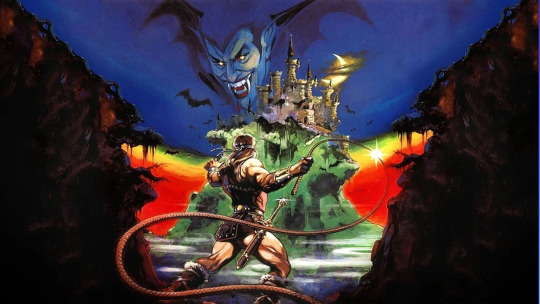
In ten days it will be World Dracula Day, and I’ve had the Count of Transylvania on the brain quite a lot lately. (A few of you can guess why.) Even though my Vincent Price countdown is still ongoing, I thus decided it was time to pay a bit of tribute to one of my favorite video game franchises, which happens to involve Dracula. I speak, of course, of Castlevania. Originally designed to be simple platform action/adventure games with a spooky motif, the Castlevania series has evolved over the years. The core or “Classic” series has continued to have occasional spin-offs, and there’s also a reboot series called “Lords of Shadow,” and an animated series on Netflix, both of which make their own adjustments to the lore and characters while staying true to elements fans have come to love over the years. Over the course of the franchise’s history, many fabulous characters have come and gone - heroes and villains alike - and I decided, since Dracula is such a big part of Castlevania’s identity, it would be a fine idea to give a tribute on this day to my favorite figures from the series. Some of them may surprise you. With that said, let’s waste no more time! Grab your bullwhip or sword of choice, and prepare to enter battle! These are My Top 15 Castlevania Characters!
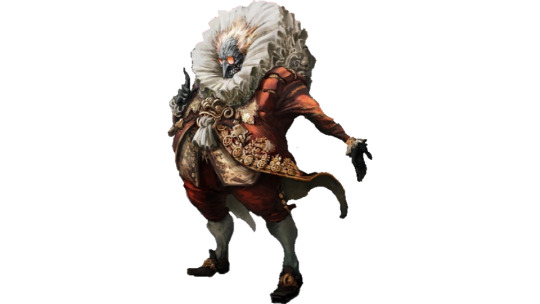
15. The Toy Maker.
The first two character entries on this countdown are exclusive to the aforementioned “Lords of Shadow” reboot trilogy. Originally intended as a re-VAMP-ing (I am so sorry) of the series for a new generation, this new line of interactive titles only lasted for three games. Fans were and still are mixed in their feelings about the Lords of Shadow reboot: some enjoyed it, while others felt it strayed too far, in terms of storytelling and style, from the original vision of the series. Personally, I like the Lords of Shadow trilogy; in fact, my favorite game of the franchise is from this trilogy…but that’s another story for another day. One of the more important antagonists of the reboot was this maniacal malefactor: a devilish scoundrel known simply as “The Toy Maker.” Loosely influenced by Jekyll & Hyde, the Toy Maker was once a kindly old soul, who used incredible science and alchemy to bring smiles to small children. However, a series of tragic events led to him being possessed by an evil force, under the influence of which he developed a sort of split-personality: flip-flopping between a sweet and gentle figure of fun, to an unhinged and sadistic hobgoblin who would make the Joker look as scary as a ball of cotton candy. The Toy Maker was an interesting and fun antagonist, and I really wish we could have seen more of him…however, the Lords of Shadow reboot trilogy remains the only place where he appears, so far.
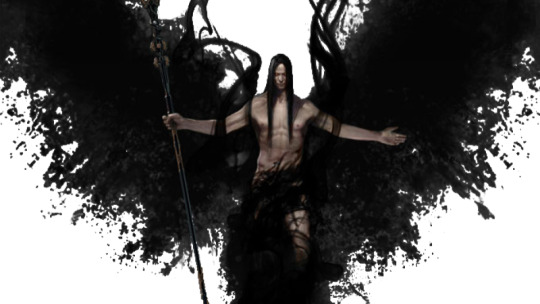
14. Satan.
This is the other LoS exclusive character on the countdown. As anyone who knows anythin about Castlevania knows, Count Dracula is the main antagonist of the Classic series of games, as well as the first two seasons of the animated series. However, in “Lords of Shadow,” the novel decision was made to make Dracula not the main villain, but instead the main protagonist (at least for two out of three games). So, with the Count now our hero rather than our villain, who was the antagonist to be? Who better than the Devil himself? Yep: in “Lords of Shadow,” Satan himself is the secret driving force behind much of the action of the story, and appears in the final act of the game as the true main villain pulling the strings behind the scenes. Although he was defeated, the Fallen Angel would return in “Lords of Shadow II” as the main antagonist, with Dracula facing his many minions and monsters before engaging in a rematch with Satan at the final bow. The character was masterfully played by the great Jason Isaacs, and I don’t think you could have picked a better main villain for this concept if you tried. However, once again, Satan only shows up in the LoS reboot, and despite his importance in the overarching story of the three games, his time onscreen is surprisingly small. Therefore, I don’t think it’s fair to rank him any higher.
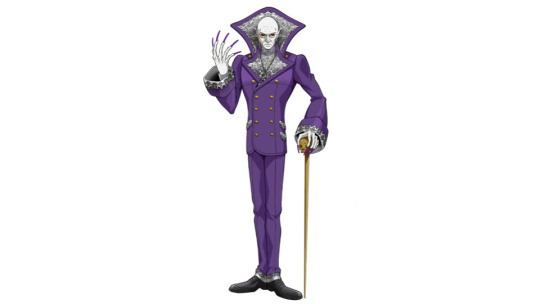
13. Brauner.
This is the first of many characters on this list to appear in more than one version of the Castlevania universe. Brauner first appeared as the main antagonist of one of my favorite games in the Classic series, “Portrait of Ruin.” He’s probably my favorite oneshot villain of the entire franchise. The character is a tragic antagonist: a former artist driven mad after the death of his daughters during World War I. Brauner studied black magic and became a vampire as a means of taking revenge against humanity, blaming the ills of the human race for the loss of his children. In his insanity, he came to believe two different young ladies were the reincarnations of his daughters, turning them into vampires and brainwashing them into believing the same. Brauner uses his powers to infuse his paintings with evil magic, turning them into weapons and then using special portraits to restore Castle Dracula. Unlike most bad guys in the series, Brauner has no connections to Dracula, nor any desires to resurrect him: he simply means to use the power of the Castle itself for his own diabolical and deranged purposes. Top it off with a character design inspired by Count Orlok from “Nosferatu,” and you have a memorable fiend indeed. The character returned in a reimagined form in the “Lords of Shadow” series, but in my opinion, this second incarnation was a major downgrade. This version of Brauner was a burly, monstrous vampire warrior, who acted as a lieutenant to the evil Carmilla. He was an intimidating presence, and a fun boss fight, but there really wasn’t much to say about him, and he was a far cry from the commanding and complex figure from the Classic series. I will say though: making him the brother, in that universe, of Olrox - another character from the Classic games inspired by Count Orlok - was a nice little in-joke.
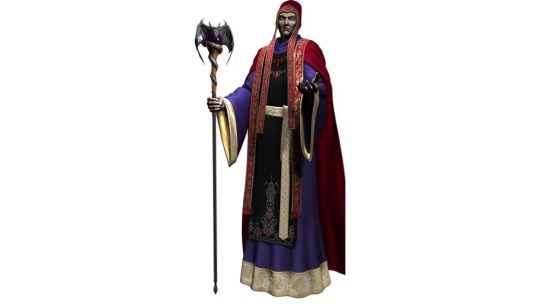
12. Shaft.
Shaft is a major antagonist in several of the Classic Castlevania games, most notably “Rondo of Blood,” its remake “Dracula X Chronicles,” and the ever-applauded “Symphony of the Night.” (And yes, you may snicker at his name and play a certain theme song whenever you read it, if you wish.) This fellow is a classic example of the “Dark Priest” or “Mad Priest” archetype. He’s dramatic, uses dark magic to face his foes, and zealously devoted to his Lord and Master: Dracula himself. In the aforementioned games, Shaft helps to resurrect Dracula, and aids him in his quest to destroy all of humanity. Admittedly, there’s not much else to this guy: he’s far from the most complex or sympathetic villain of the franchise, but he’s one that many people consider an iconic foe, and has even been the inspiration for other, rather similar villains in later games, such as Death’s alter-ego “Zead” in Curse of Darkness, and Guido Szandor from the Lords of Shadow games. Indeed, some have suggested that the Bishop played by Matt Frewer in the animated series may be inspired by Shaft. The two have a physical similarity, if nothing else, although Frewer’s Bishop is a zealous Christian rather than a vampire-worshiping occultist. Whatever the case, he’s an iconic scoundrel; when I think of the archetype, he’s one of the first characters I think of. For that reason above all, he earns his place in the ranks.
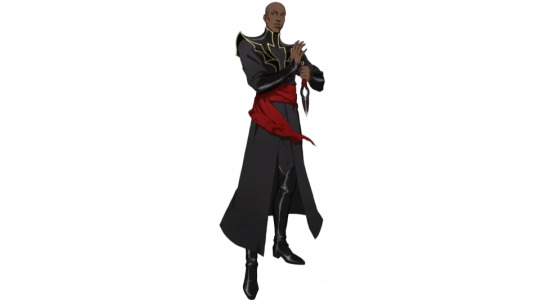
11. Isaac.
Isaac first showed up in one of the Classic games, “Curse of Darkness,” as a major antagonist. In the game, he was the friend-turned-nemesis of the main protagonist, Hector. Both of them once served as Dracula’s Devil Forgemasters, using arcane arts to help form armies of the undead for the Count. However, Hector eventually saw the light and left Dracula’s employ, while Isaac remained loyal to Dracula. Isaac orchestrates a series of cruel and sadistic trials to lure Hector back to Castle Dracula, intending to use Hector as a host body for Dracula’s evil spirit. This version of the character was already a fun one: an utterly deranged sadomasochist whose depravity served as a dark mirror to the hero, and whose connections to him made him a particularly personal threat. However, Isaac REALLY became fascinating in the Animated Series: this version kept the basics of the character, but changed his personality and story arc. Isaac lost his maniacal edge, and was made into a more tragic figure who, like Hector, learns to step out from Dracula’s shadow and find a new path in life. The pair were depicted more as rivals than nemeses, and many fans feel that Isaac’s journey through the show was one of the best parts of the overarching series. It was a great reimagining that actually improved on the established character from the games…but I personally just like other characters, across the whole franchise, a bit more, so I don’t think he deserves a spot in the Top 10. Sorry, Isaac; I still love ya.
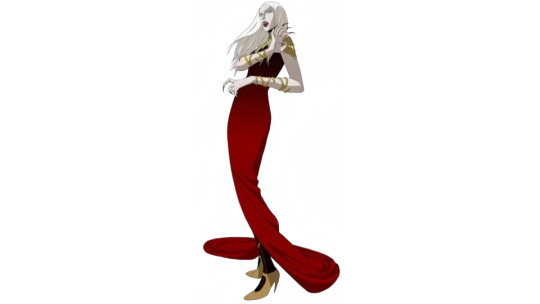
10. Carmilla.
Carmilla – sometimes called “Camilla,” depending on the game you look at – can be seen as a study in the evolution of a character. She originally appeared as a recurring boss in the series, popping up in a few of the early games, such as “Simon’s Quest” and “Rondo of Blood” (and “Dracula X Chronicles” by extension). In these games, she wasn’t really a fully formed character in the truest sense; we didn’t know much about her. Her name was taken from the titular character of the most popular classical vampire story besides Dracula, “Carmilla,” and she was presumably inspired by the Hammer Horror films based on the story…but that was about it. There wasn’t really a lot of personality or major backstory to her. Things changed, however, with the game “Circle of the Moon.” While not set in the same continuity as the rest of the Classic series, the game was very notable in that it changed the character from a minor recurring boss figure to a major antagonist in her own right. In that game, much like Brauner in “Portrait of Ruin,” she was the true main antagonist, enacting an elaborate scheme to resurrect Count Dracula for her own evil ends. After this point, Carmilla started to get more and more attention: in the “Lords of Shadow” reboot, she was once again a fairly noteworthy antagonist, being one of the few characters to appear in both the first game and LoS2. Then, in the animated series (the version pictured here), she served as the secondary antagonist of the (appropriately) second season, and then became the main threat in the following season. She remained a major villain from that point on, basically up to the end of the show. With every installment that gives her more focus, Carmilla has become more fascinating and more twisted as a villainess. From humble beginnings to much greater prominence, it seems like anywhere Castlevania goes, Carmilla is destined to go with it.
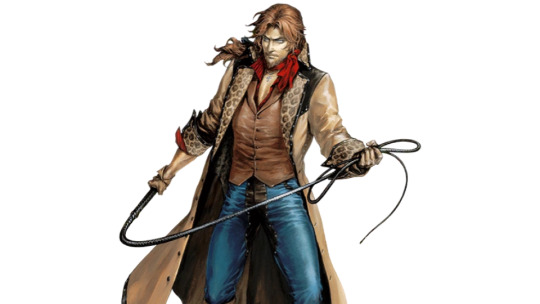
9. Julius Belmont.
When you really get down to it, Castlevania is the story of two opposing forces: Dracula, and the Belmont Clan. The Belmonts are a family of professional monster hunters; a noble race of warriors who have been fighting evil for generations. Each Belmont who takes up the weapons of their trade knows that they may be the one to face Dracula when the Count inevitably returns, and while all of them have similar goals, motivations, and abilities, they are generally unique from each other. Julius Belmont is a major character in the games “Dawn of Sorrow” and “Aria of Sorrow” (which are really the same story split in two). In these games, he is presented as the last of the Belmonts; the final member of his lineage. He is also one of the most powerful of his family, if not THE most powerful: experienced and gifted with knowledge passed down to him for centuries, and more than equipped to tackle Dracula. This becomes a problem, however, when he ends up befriending Soma Cruz – the main protagonist of the two games – and learns a dark secret about Soma’s being…but that’s another story. I really love Julius; a grizzled and INCREDIBLY powerful warrior, he has one of the most dynamic arcs of any character in the Castlevania series, starting off as a friend, briefly becoming an enemy, and then becoming something of a friendly rival and even a mentor. As the chronological last of the Classic Belmonts, he’s also quite important: with him, the clash between his family and Dracula effectively reaches its end. My only problem with Julius is not even really his fault: I really wish we could have gotten a game about the time Julius fought Dracula, with him as our main protagonist. It would have been nice to have him as our lead, rather than just a supporting role. It’s for this reason alone I don’t place him any higher. I guess one could argue we did get a chance to play with him in Dawn of Sorrow’s “Julius Mode,” but…that’s a bit of a different story.
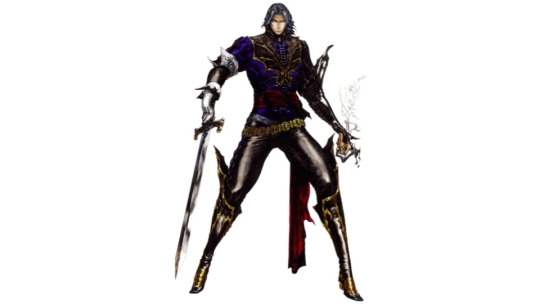
8. Hector.
Our first main protagonist character on the list…but interestingly, not a Belmont. Hector is the main character in “Curse of Darkness” (a personal favorite of mine from the Castlevania series), and is one of the most interesting main protagonists for a very specific reason: he’s a case of a villain turned hero. As I said before, Hector is a former servant of Dracula. He was once one of the Count’s most trusted soldiers – one of the few mortals Dracula cared about and considered a friend and worthy ally. However, after some time, Hector began to realize that Dracula’s crusade was not one he wanted to be a part of anymore, and he thus fled from his old master to find a new life. He fell in love, got married…and eventually saw his beloved wife killed as a result of the machinations of his former ally, Isaac. Wishing to avenge his wife, and stop both Dracula and Isaac once and for all, Hector thus gathers his weapons and goes back to the Castle to face his former comrades. Villains who are now heroes are always a great blend, and it makes the battle Hector goes through much more personal as a result. When he faces Isaac and the Count, it’s not just about his beloved’s death, but about facing his own inner darkness, and ensuring he can overcome it and see to it no one else gets hurt the same way. I also really loved the way the character was portrayed in the animated series, which stuck true to Hector’s origins while giving a new spin to his motivations and personality. (Much the same way the show did with Isaac.) He’s a character I don’t think gets enough credit from fans at times – I often hear other protagonists being spoken of more openly – but for me, he’s a shoe-in for the top ten.
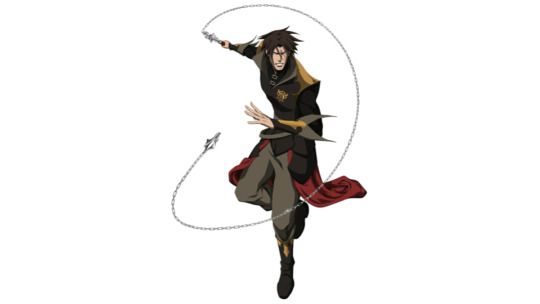
7. Trevor Belmont.
Of all the Belmont Clan, Trevor is one of the most recurring, and my personal favorite. Much like Carmilla, this is a character who has seen a lot of evolution. He first appeared in one of the games from the original trilogy, “Dracula’s Curse.” That game came out in 1989; back then, no one really cared THAT much about the story and characters: games were just games, so to speak. But as time went on, Trevor would appear in more titles, and his personality would evolve. He’d first appear as a major supporting player in “Curse of Darkness;” this version depicted Trevor as a noble but somewhat rash warrior, perhaps too overconfident in his own abilities. He starts off distrustful of Hector, but later becomes a valuable ally. This version would also appear as a supporting character in the fighting game “Castlevania: Judgment.” (Which could have been so much better, if people had been a little smarter when making it.) In the “Lords of Shadow” reboot, the character SORT OF reappeared: in that version, Trevor’s character was essentially combined with Alucard’s. (More on that matter later.) Finally, and most recently, Trevor appeared as the main character in the animated series. (That’s the version pictured.) In the show, Trevor is a disillusioned but ultimately good-hearted warrior, who has to learn to trust himself and others during his quest to slay Dracula and save the human race. After he and his allies do, indeed, defeat Dracula, Trevor’s adventures are not done, as other antagonists - such as Carmilla and Death - soon enact their own plans once the Count is out of the picture. All of these versions are interesting, and while many would probably name Simon or Richter as the most iconic Belmonts in the franchise, for me, Trevor will always be the best of the bunch.
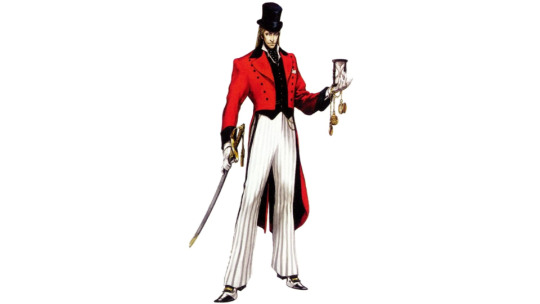
6. St. Germain.
This cryptic character is yet another alumni from the game “Curse of Darkness.” (Don’t worry, I think he’s the last CoD-exclusive figure in the ranks.) He is the very definition of a scene-stealer: while his time in the game is actually relatively small, he makes a HUGE impact. This eccentric gentleman is a time traveler, and a perennial mystery. He frequently speaks in riddles, and while he seems to know a lot about Hector and the whole situation of the story, we actually don’t know very much about him at all. While it was later revealed in “Castlevania: Judgment” that St. Germain is a member of a secret organization of time travelers known as “The Time Watchers,” his exact motivations for his actions throughout Curse of Darkness are still unclear. In some ways he helps Hector along his journey, but he also serves as a dangerous boss battle, and tries to convince him to halt in his quest at one point. You’re never really sure what he’s going to do or say; an unpredictable trickster with powers we don’t fully understand. I always love these kinds of “Trickster God” or “Chaotic Entity” figures: characters like the Cheshire Cat, Puck, Mr. Mxyzptlk, and Q, for instance. Never truly evil nor truly good, and not fully understandable in their methods. St. Germain is a classic example of the same trope. The character was later adapted to the animated series: much like with the other Curse of Darkness characters, the series kept many of his original elements intact, but also added some new flourishes all its own. The show humanized St. Germain, giving him a more “grungy and gritty” reinterpretation of his classic design, and going into more detail about his origins and goals. Both takes on the character are magnificent, both for the same and for totally different reasons. Honestly, I’m sort of surprised he never made it into the Lords of Shadow reboot between these two incarnations…but que sera sera.
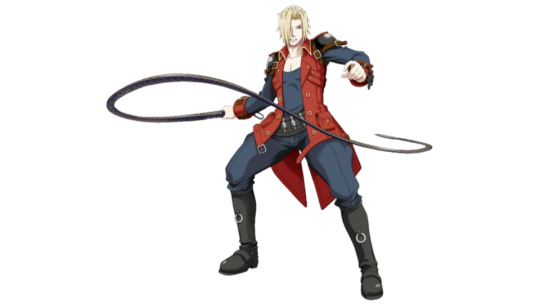
5. Jonathan Morris.
I’m not sure how renowned Jonathan Morris is among general fans of the Castlevania franchise, but for me, he is most assuredly one of my favorite protagonists in the series, and a big part of why “Portrait of Ruin” is among my favorite games in the franchise. First and foremost, there is his connection to the literature of Dracula: Jonathan is a descendant of Quincey Morris - a much-underrated character from the Bram Stoker novel. In the book, it is Quincey who is truly responsible for Dracula’s destruction. (His first name is also taken from a character in the book, Jonathan Harker.) I’ve always loved the fact that not only is the book canon with the rest of Castlevania (somehow), but that, of all characters, it’s Quincey Morris who gets attention. This also makes Jonathan one of the few American protagonists of the series. In fact, he comes from Texas; as a Texan myself, I find this incredibly appealing! But beyond the book and the geographical appeal, I love Jonathan for his personality: the game focuses a great deal on teamwork, both in gameplay and in storytelling. Jonathan does not travel alone: he is accompanied by his best friend, Charlotte Aulin. Charlotte is a wonderful character, too: the pair make a sort of “brains and brawn” duo: Charlotte is a good witch, who uses magical attacks and defenses, and is exceptionally smart. Not only is she skilled in sorcery, but she is also well-versed in science and other subjects, and always tries to use her head to confront a problem. Jonathan, in contrast, is all about muscles, using melee attacks with his sword (and, eventually, the legendary Vampire Killer whip), and is rather hotheaded and impetuous. He’s got a slight temper, and can be much too overconfident…but you know that his heart is in the right place, and he does listen to Charlotte when push comes to shove. Indeed, it’s Jonathan’s flaws that create much of the drama in the story, as he has to learn to rein in his impulses, among other things, in order to earn the power to use the magical Vampire Killer. Only with Charlotte’s help, and through learning to use his help, is Jonathan able to do what his grandfather, Quincey (and his father, John) were able to do, and defeat the Count of Transylvania.
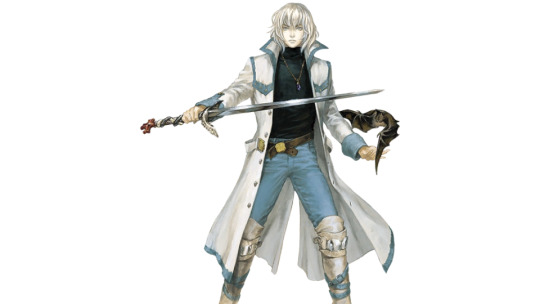
4. Soma Cruz.
Soma is the main character of “Aria of Sorrow” and its sequel/second half, “Dawn of Sorrow.” He’s also appeared in a few other games since. Many consider him to be possibly one of the greatest protagonists of any Castlevania game, and I am no exception. At the start of “Aria,” Soma is a seemingly more-or-less average High School student living in Japan. He has no family of his own, so he lives with a friend of his, Mina Hakuba. (Nice reference to Mina Harker there, games. A+.) One day – right the flip out of nowhere – Dracula’s Castle pops up in the middle of town, and Soma and Mina are trapped inside. At first, all Soma wants to do is leave the castle and save Mina, but as the story goes on, he starts to realize things about himself. He suddenly finds he has remarkable powers and surprising fighting skills he’d never been able to use before. He also discovers he has the power to consume the souls of anything (and anyone) he kills. At first, he naturally tries his best to be responsible and good with these powers…but things take a turn when it’s revealed why he has these abilities to begin with. Soma is actually a reincarnation of Dracula himself. The Count’s spirit dwells dormant inside of him, but it is foretold that someday he will manifest again. The remainder of “Aria” and the story of “Dawn” thus have Soma battling with his literal inner demon (or vampire, I suppose). The games play with the themes of destiny and fate, as the question constantly arises: is Soma doomed to BECOME Dracula, his life being erased? Or can he live his own life, the way he wants, without worrying about such a thing? Is there any compromise that can be reached between these two radical extremes? Is Soma Cruz a hero-in-the-making or a villain-to-be? It’s this constant struggle that makes Soma such an intriguing protagonist, as we, the player, pilot him on his journey towards whatever he must become. We care about him deeply, through all his trials and tribulations, and we don’t want to see him fall to darkness. The question is if he can truly avoid it. I won’t give away how things end, but suffice it to say, Soma’s adventures are some of the most poignant of any Castlevania character.
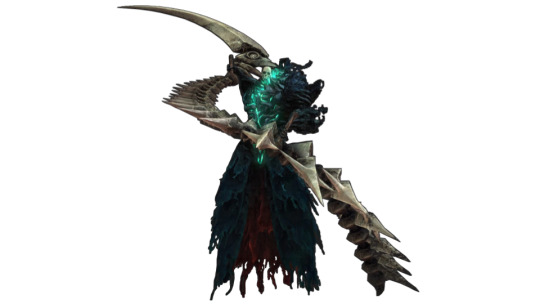
3. Death, a.k.a. The Grim Reaper.
Death is unavoidable, inevitable, and persistent. This is not only true of mortal life, but it is also true in the world of Castlevania. The Grim Reaper himself is the secondary antagonist of the entire franchise, and each separate version of the Castlevania universe reinterprets the character in a brand new way. In the Classic games, Death is Dracula’s second-in-command, and quite possibly his only true friend. The Reaper is the Count’s most loyal henchman; he is actually fought and faced in even more games than Dracula himself, usually as the penultimate boss (and, in at least one case, as the final boss). One of my favorite moments in the entire Castlevania series is the dual battle against both Dracula AND Death in “Portrait of Ruin”: by far my favorite boss fight of the entire franchise. In the “Lords of Shadow” Reboot, Death - also known as Zobek - is played by the redoubtable Patrick Stewart. (This is the version pictured here.) In this universe, things were turned on their head: Zobek starts off as an apparently friendly source of aid in the first game, but it’s ultimately revealed he’s just been using Gabriel (the future Count Dracula) as a means to his own evil ends. He returns in “Lords of Shadow II,” where he and Dracula forge an uneasy alliance…but by the end of the story, the pair once more find themselves at odds, leading to one of the best boss battles of the entire trilogy. While Satan is the main villain of the reboot, Zobek is Dracula’s TRUE nemesis. Finally, in the Animated Series, Death is reimagined once again, and combined with the penny dreadful figure Varney the Vampire. In the final season of the show, Varney is the main antagonist, and is ultimately revealed to be the Grim Reaper in disguise: he’s mighty peeved about Dracula’s destruction (albeit for completely different reasons than in the Classic games), and seeks revenge upon Trevor Belmont and his allies for the Count’s loss. This version was played with hilarious crudity by Malcolm McDowell. I love all three versions of the Reaper in the franchise. If there’s one thing these games prove without a shadow of a doubt, it’s that you cannot hide from Death.
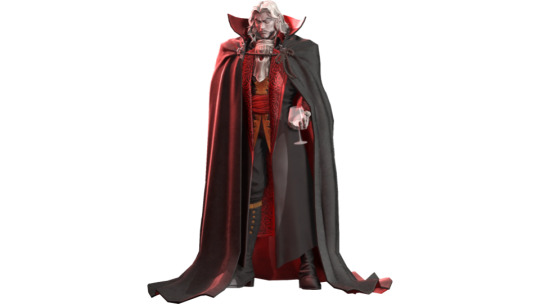
2. Count Dracula.
And here he is, at last! The King of the Vampires, the Prince of Darkness, the Count of Transylvania, He Who Sells Chocolate Cereal…Dracula! I bet you all thought he’d be number one, didn’t you? Well, surprisingly, no, but we’ll get to that issue in a minute. Let’s focus on good ol’ Drac himself for a second, shall we? Dracula is the main antagonist of the original Classic game series: he appears in nearly every title, usually acting as the final boss. Even in the stories where Dracula either does not appear or simply does not act as the last boss, however, his impact on the series’ storyline is profound. This version of the legendary villain is both sympathetic and sinister: his reasons for his evil deeds are complex and varied, but there can be no denying the cruelty of his wicked ways. He is insanely powerful, with many magical abilities and immunities; every time the heroes think he’s down for the count (no pun intended), Dracula always finds a new way to return and bedevil the world again. In the “Lords of Shadow” reboot, like I said earlier in the list, Dracula is actually reimagined greatly: in the first game, we meet him as a monster hunter called Gabriel Belmont. It isn’t until the second game, “Mirror of Fate,” when he becomes Count Dracula and assumes his usual role as the main antagonist. In “Lords of Shadow II,” the third game of the bunch, he acts once more as the main protagonist, this time as a sort of anti-hero, torn between both the heroism and the villainy of his past lives. Then, in the animated series, Dracula acts once again as the main antagonist of the first two seasons; although he is defeated by the end of Season 2, both his actions and those of the ones who beat him continue to plague everyone’s lives for the next couple seasons onward. Every single version of Dracula is absolutely glorious. Castlevania’s Count is easily one of my favorite versions of the character, and the Classic rendition is one of my favorite video game villains of all time. Yet he’s only second place on my list…what heresy have I cooked up, one wonders?
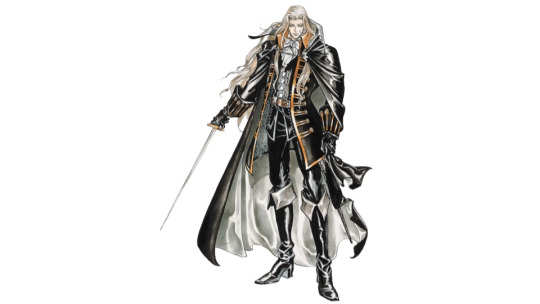
1. Alucard.
Who else could possibly top Dracula but his own son? While the Belmont clan may be the main collective protagonists of the series, Alucard, to me, is one of my favorite heroes in video game history, and a solid shoe-in for the number one spot here. Alucard is not technically a vampire, but a dhampir: half-human, half-vampire. He first appeared in the game “Dracula’s Curse.” However, Alucard really didn’t become popular or interesting until “Symphony of the Night.” In THAT game, we learned the full story of his origins, and the exact nature of his relationship with his bloodthirsty father. Alucard loves his father, and knows that, deep down, there is genuine good in him. But when Alucard’s mother, Lisa, is killed by witch hunters, the two forge different paths. Dracula’s instinct is vengeance, as he goes on a crusade to destroy all of mankind! Alucard, however, knows that isn’t what his mother would want, and chooses to defy his father as a result. After Symphony of the Night, Alucard continued to appear in numerous games, sometimes as a main protagonist, and sometimes as a featured supporting role. Like I said before, in the LoS reboot, his character was combined with Trevor Belmont. I’ve always had mixed feelings about this: on the one hand, it almost feels like a disservice to Trevor as a separate character. On the other hand, I actually didn’t mind the new take on Alucard, overall, as it kept many of the same ideas while twisting things slightly to fit the new universe and storyline. I still prefer the original more, however, and always will…which brings us to the animated series. This, I think, is probably the best Alucard we’ve ever gotten: sticking true to the original, but now giving him a sense of humor and playing with his own inner demons in some unique ways. Regardless of which universe you look at, however, I love the character’s swashbuckling and dramatic touches, while still being a legitimately compelling character. When I think of Castlevania, he is one of the first characters I think of. For all these reasons and more, I happily dub Alucard as My Favorite Castlevania Character.
HONORABLE MENTIONS INCLUDE…
Sypha Belnades.
Richter Belmont.
Charlotte Aulin.
Cornell.
#top 15#countdown#list#best#favorites#characters#castlevania#video games#tv#animation#lords of shadow#dracula#horror#netflix#alucard#grim reaper#soma cruz#jonathan morris#st. germain#trevor belmont#hector#julius belmont#carmilla#camilla#isaac#shaft#brauner#satan#toy maker#count dracula
13 notes
·
View notes
Note
tumblr user hee-blee i am trying to make a visual novel WHAT is the process like where do i start lol!?!?!?!?!?!?!?!?!?!?!
hello anon, I am very happy to talk about this!! story-based games are a big interest of mine and while I am by no means an expert I do have some experience (I currently have four story-based games in the works and one demo out on itch.io) so I can offer a bit of advice based on my experience so far.
I think the very first thing would be to research visual novel/interactive story game-making programs. there are a variety of different ones out there, and going through tutorials for your program of choice will give you the best idea on what you'll have to do to put your novel/game together. I've been putting all my games together in the ren'py visual novel engine, which I have found to be fairly accessible and intuitive once you get the hang of it. there are lots of tutotials and videos and forums to learn from and ask questions in available, and the ren'py creator community seems very nice and helpful especially towards beginners.
regardless of your program, there are a few basic things that you can do to get started: 1) planning out your story (or stories if you have multiple paths; I personally find it helpful to have a document with all the story paths written out before I start coding to help keep myself organized, and to have a collection of character sheets on hand for the main cast, as characters are the most important part of visual novels/interactive stories), and 2) making sprite libraries and backgrounds (collections of images of your characters with different poses/expressions and the various settings for your stories. the basic setup for visual novels is sprites on backgrounds with dialogue/text, and you can definitely make a lovely visual novel using just those things. you can add in a ton of other elements if you want--there are lots of ways to get creative with visual novel/interactive story engines--but it's easier to keep things simple your first time around to avoid overwhleming yourself.
I'd also suggest checking out other visual novels for inspiration (itch.io is a great place to find free indie story-based games and visual novels), and taking a while to go through google and youtube to learn about how other people make their visual novels--the more perspectives you get, the more tips and tricks you'll learn.
some general pointers I have for people starting out with making visual novels/interactive story games:
- back up your code often! I copy and paste mine into a google doc every so often to make sure I have a back up of it just in case something happens to my active script, and for good measure I also copy my wip game files over to an external hard drive every once in a while just in case.
- don't worry about stylistic elements (title screens, menus, user interfaces, decorative flourishes, etc) until closer to the end of your coding process. I find it a lot easier that way as opposed to trying to tend to both the game script and the stylistic elements at once. if you'd prefer, the same benefit could come from handling all the stylistic elements first right out of the gate, but I would reccomend especially for you first time to leave styling your game until the end.
- don't let stubborn errors get you down! coding--even relatively simple coding like that used in engines like ren'py--is a lot of trial and error (at least for me), and you'll have to go back a lot to search for and correct little coding errors to get everything to work right. it can definitely be frustrating, but it gets easier the more you do it, and if you get stuck a quick google search will usually get you to a forum post with a solution (and if it doesn't, you can always post in a forum yourself to ask for help).
I hope that helps a bit! I'm very heartened to encounter someone interested in making visual novels--I think they're a wonderful and super versatile storytelling form and I would encourage anyone interested in making one to take a crack at it.
if you have any specific questions or just want to talk about the process or your stories, I would be more than happy to hear about them, so feel free to dm me (invitation open to anyone interested in visual novels/interactive story-based games!) best of luck, I hope to be able to experience your visual novel(s) some day!
41 notes
·
View notes
Text
My Webtoon Recommendations
These are webtoons that are all 10/10 for me. Of course it doesn’t have to be a 10/10 for you, so just a reminder, do not attack me for liking a webtoon that you do not. These are my opinions and we are not going to have the exact same taste. Please be respectful.
Your Throne
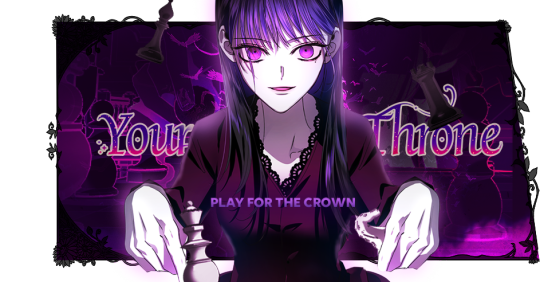
Genre: Fantasy
Chapters: 75
Status: Ongoing
-
“Tensions are brewing under the seemingly calm surface of the Vasilios Empire, a kingdom ruled by the Imperial Family and the Temple. Lady Medea Solon has lost her place next to Crown Prince Eros, but resolves to win back whats rightfully hers. Will she reclaim her throne?”
You know whats amazing about this webtoon? The summary leads you to think that what shes winning back is the prince. Wrong. Shes trying to win back the throne. I love how this webtoon doesn’t try to make it a girl focusing her goals on a man, but on power. Medea is such a strong and well written character that you can’t help but love her.
The second protagonist Pschye, who of which is the person who took Medeas place as Crown Princess, is the complete opposite of Medea. At the beginning you hate her, but as the webtoon goes on and Medea and her get a better understanding of eachother due to them switching bodies as a wish from God, you begin to root for them as they team up to take over the throne from the Crown Prince.
The art is so beautiful and I constantly found myself at awe from the amount of detail put into it.
-
The Makeup Remover

Genre: Romace
Chapters: 78
Status: Ongoing
-
“After years of being told to focus on studying, Yeseul feels lost when she starts college and is suddenly expected to pay attention to makeup. When a chance encounter with brilliant makeup artist Yuseong leads to her taking part in a televised makeup competition, Yeseul begins to question the role that makeup and appearance play in society.”
This was created by one of my favorite webtoon creators Lee Yone. Their art is just so amazing and their stories always include such good topics.
For instance, The Makeup Remover’s theme is loving yourself for who you are. It shows how people treat you based on your looks and as someone whos struggled with that kind of thing for a while, this webtoon really touched me. The main character Yeseul is such a relatable character, even when trying to reject beauty standards, she still came subject to the pressures of living up to the people around her. She struggles with trying to love her own appearance and I really like that this webtoon didn’t try to be like, ‘fuck the beauty standard im better than that screw pretty people!!!’ it actually showed realistically how people struggle with self-image. I also love the main love interest because oh my god, we need more men like him please. He doesn’t care about Yeseul’s appearance and genuinely loves her for her personality.
Also, art is amazing. The author is so talented and you should support them by reading and liking the chapters.
-
Surviving Romance

Genre: Horror
Chapters: 14
Status: Ongoing
-
“When Chaerin Eun becomes the protagonist of the romance novel she is reading, she expects a fairytale ending with the novel’s love interest, Jeha. But when a bizarre twist makes her realize the story is not playing out as it does in the book, she’ll need the help of an unlikely character from her class to defy the new storyline and find her happy ending - if only she can figure out who this ‘Unknown Extra’ is first!”
Hands down one of my favorite webtoons by a long shot. You ever see a webtoon and think, ‘oh yeah, thats going to be a good webtoon’? Thats how this webtoon was for me. It was so good that I spent hours searching for other chapters that hadn’t been uploaded to webtoon yet on other manhua websites. I discovered it because it was also by the author of ‘The Makeup Remover’.
If there is one thing you need to know about me, its that I am a huge horror fan. So when I saw that my favorite author on webtoon had a horror themed webtoon out? You bet your behind that I binged it. Let me tell you, best choice ever.
Think of it as if ‘Ino’s Law’ and ‘Quarantine’ were combined with amazing art and a badass MC.
The Remarried Empress
I love how it is set up to the point where she cannot ‘quit’ until she completes the novel. Creating scenarios where she must survive while meeting the standards in the book. It is such an amazingly written webtoon and I cannot wait for more chapters to be released.
-
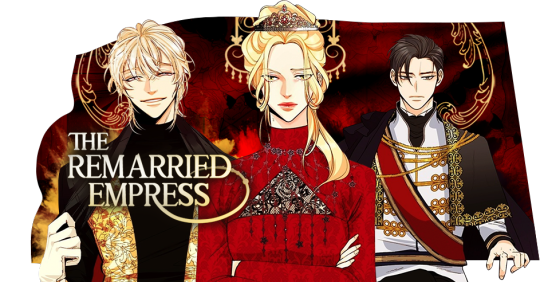
Genre: Fantasy
Chapters: 82
Status: Ongoing
-
“Navier Ellie Trovi was an empress perfect in every way - intelligent, courageous, and socially adept. She was kind to her subjects and devoted to her husband. Navier was perfectly content to live the rest of her days as the wise empress of the Eastern Empire. That is, until her husband brought hone a mistress and demanded a divorce. ‘I accept this divorce… And i request an approval of my remarriage.’ In a shoking twist Navier remaarries another emperor and retains her title and childhood dream as empress. But just how did everything unfold? “
Am I in love with Navier? Yes.
I absolutely adore how this story was set up. The first chapter begins with the big divorce scene, followed by Navier saying that she was going to be remarrying someone else since he wants to divorce her. This sets up a picture that gets completely shattered as you read the chapters. How everything falls into place with the reason behind the divorce and the remarriage is just so well written. The art is so good and and everything is just so insanely well done.
I absolutely love Naviers character, from her regalness and devoted loyalty to her role as empress, all the way to her petty moments and times of sadness. She is truly a character that you want the best for, and I cannot image anyone not liking her. Also the story is just so capable of making you feel emotions. I’ve laughed, cried, and got angry during the course of reading this webtoon. I love how betrayed I felt when the emperor brought home his mistress. It felt like I was in Navier’s shoes!
This is such a well done webtoon and I'm so excited for Navier to get all of the good things she deserves in her new Kingdom and with her new husband.
-
Witch Creek Road

Genre: Horror
Chapters: 74
Status: Ongoing
-
“A survival horror about love, acceptance, death, and revenge. And sexy flesh-eating demons. Yeah, it has those, too.”
This series seriously mind fucked me. The way that this story is set up, you don’t see the full picture until the later chapters. Season two literally blew my mind. It is also very gorey so keep that in mind if you don’t like that kind of stuff, but for me that makes it all the better. It is just so wild and crass that you can feel your heart pumping in anticipation.
They even have their own website that goes further into the lore because it’s just so wild. Also the art style is just so amazing, because it complements the story and horror theme so much. You hate most of the characters because they suck, and it is so satisfying when they are killed. Also it has it’s sad moments but I think it is a nice break from the horror so it isn’t so overwhelmingly scary.
I binged this series and I recommend reading only a few chapters a day so you don’t overload your brain.
Other then that, an amazing webtoon. Seriously, go read it, support the author, so much work goes into the story and art that it’s insane.
-
Dating With A Tail
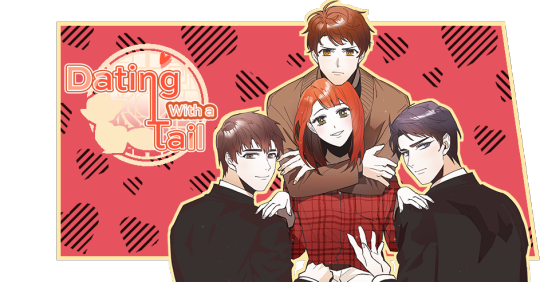
Genre: Romance
Chapters: 36
Status: Ongoing
-
“On the dawn of her 29th birthday, unlucky-in-love Yunha discovers a shocking family secret: she’s started growing a fox tail, the mark of an ancestral curse. She must find her fated love before her 30th birthday or she is destined to become a fox forever! Even with her new-found enchanting power to attract men using her scent, will one year be enough to break the curse before it’s too late?”
Oh my gosh this is just such a good webtoon. It has amazing art, story telling, and characters. The true love interest was there the whole time, the villain isn’t who you’d expect it to be, and the spirit who cursed her is just! Im not going to spoil it but go read this webtoon!! It is so good and deserves more love.
Also Yunha is just so relatable?? Like she put off finding the woodcutter (her fated love) for 29 years and waited last minute to find him. Homegirl is me trying to do a project for school. Also to get rid of the scent that makes men attracted to her, she just starts eating a ton of garlic and that is just so funny to me.
Also I would go to church for the priest anytime if you know what i mean ;)
-
Omniscient Reader
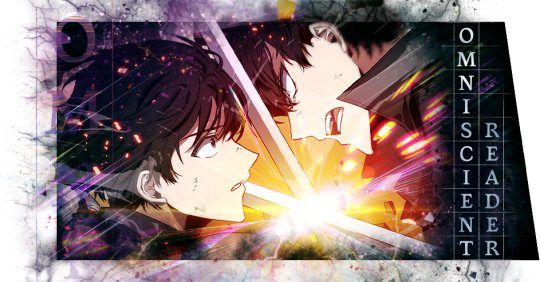
Genre: Action
Chapters: 53
Status: Ongoing
-
“Dokja was an average office worker whose sole interest was reading his favorite web novel ‘Three Ways to Survive the Apocalypse.’ But when the novel suddenly becomes reality, he is the only person who knows how the world will end. Armed with this realization, Dokja uses his understanding to change the course of the story, and the world, as he knows it.”
I cannot get over how high quality this story is. The world building is phenomenal, the art is fantastic, and the characters are very fleshed out. This deserved all the hype it has gotten so far and more.
I love the ‘mc thrown into a different reality’ trope so much. Just like with surviving romance, Dokja’s world became the story he was reading. Also a very cool aspect of the story is the level up and the fact that its like a game. Earth has turned into this show for god like creatures to watch and it follows Dokja trying to survive. I also really like that TWSA has a protagonist, but Omniscient Reader’s protagonist is not the protagonist that was in TWSA. There is just so much lore and I’ll say it again, the world building is just phenomenal.
The Ddokkaebi’s and Dokja’s interactions are also just some of my favorite moments from the story so far. And oh my goodness I would die for Lee Gilyoung. Thats it, thats the tweet. That little boy could probably kill me with his giant praying mantis and I would let him if it would make him happy.
-
Not So Shoujo Love Story
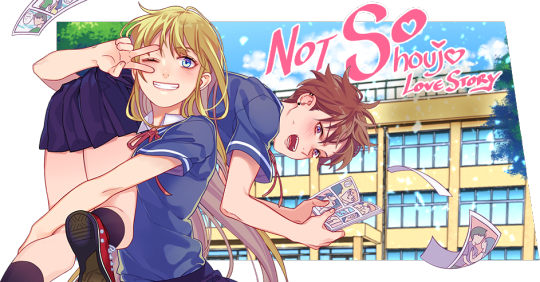
Genre: Comedy
Chapters: 45
Status: Ongoing
-
“Romance super-fan Rei Chan is ready for her first boyfriend and she knows just who it’ll be: the most handsome boy in school, Hansum Ochinchin. But her plans for the perfect story are derailed when the most popular girl in class declares herself a rival… for Rei’s heart?! This is the year her not so shoujo love story begins!”
This is just such a cute webtoon. The style is very appealing and while the humor can be childish and weird sometimes, it still has made me laugh a lot. I know the humors not for everyone but just keep in mind that it does get better as the story progresses and gets more serious.
Also its a gl! I’m really unable to find good gls these days that don’t fetishize wlw relationships. Rei being painted as a mean trouble maker whos just misunderstood and Hana being the ‘perfect girl’ who only wants Rei’s attention is such a cute dynamic. They balance each other out and better each other. Also stan Rei for constantly sticking up for Hana even if she doesn’t necessarily like her in the beginning, she has very good morals and sticks to them.
Also the defying stereotypes in this webtoon? Just god-tier. Really makes you think twice when you judge someone just on first impressions alone.
-
Odd Girl Out
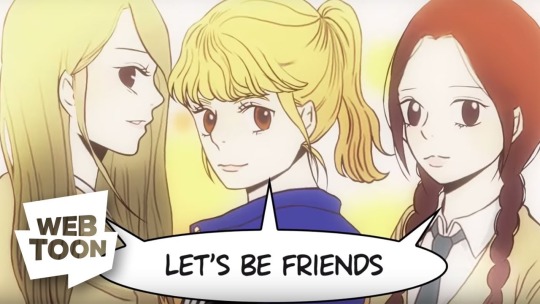
Genre: Drama
Chapters: 264
Status: Ongoing
-
“After a successful winter break makeover, Nari is finally ready for her high school debut. But somehow, she ends up friends with the three prettiest girls in school! Follow Nari as she tries to navigate her brand new high school life surrounded by beauties.”
This story has made me cry multiple times. A lot, even. It is just such a beautiful tale of friendship and finding support in people who are unlike those around theme. It also tells a great story about how anybody can be the ‘odd girl out’. Be it the fat girl, the beautiful girl, the rich girl, or the laid back girl.
It goes so deep into its characters that you even feel bad for the minor antagonists. It really makes you feel for the characters and the reasons behind their actions. Also I know its long, believe me I binged all 260 chapters in the span of three days, but oh my god it is worth it. Also I know the art is kind of off-putting, in fact that’s kind of why I put off reading the story, but I’ve honestly grown to love it and the writing is so good that the art could be literal stick figures and it wouldn’t matter.
The story is amazing and also I just love Nari. She’s just the best.
-
Gremoryland

Genre: Horror
Chapters: 67
Status: Completed
-
“Six old school friends are invited to be the first visitors of GremoryLand, a new horror theme park that promises an experience as unique as it is spooky. But once this experience starts there is no turning back, and they find themselves tested beyond what they imagines, facing their most desperate fears in order to survive.”
This is definitely one of those stories were you kind of need to turn of your brain and choose to ignore ‘plot holes’ while reading the early chapters because this story definitely gets crazy if you don’t know the ending. Believe me if you stick with it it will all make sense and the satisfaction you get from finding the ending is just so worth it.
The story is so good, and who Gremory is you would literally never suspect. When it was revealed who Gremory was and how he was able to create Gremoryland is so fucking mind boggling that you would never guess. I had to do a double take. It wasn’t like one of those random characters with a vendetta type of twists, but like one you can pick out from clues throughout the story.
Its so good and twisted and just so worth at least giving it a chance.
-
These were some of my favorite webtoons on the app! Of course it’s not all of them because unfortunately there is a 10 image limit. I also made this because I’ve run out of new webtoons to read and would love if you guys commented some of your own recs. I can also do a part two with other ones I liked if y’all want more recommendations. You guys can even request specific categories like Drama or Sci-Fi and I can tell you my favorite ones from that genre.
Also a reminder - if you disagree with any of my praise of these webtoons be respectful about it. At the end of the day it’s my opinion and you don’t need to be rude when disagreeing with that opinion.
#webtoon#Your Throne#the makeup remover#surviving romance#the remarried empress#witch creek road#dating with a tail#omniscient reader's viewpoint#omniscient reader#not so shoujo love story#odd girl out#gremory land#webtoon recommendation#webtoon review#comics#web novel#romance#horror#action#comedy
136 notes
·
View notes
Text
Meet the Team: Lindsay
Name: Lindsay
Tumblr URL: @noahmarshallapologist and @win-chan
Country: United States
Age: 25
Favorite food: Family’s sweet and sour chicken recipe
Hobbies/Interests outside of choices: Writing novels, composing, reading, watching TV, and playing video games. My favorite games is Dragon Age 😍
***
Favorite Choices book: It Lives and Endless Summer.
Favorite Choices genre: Mystery/adventure, extra points if there’s a great romance arc sprinkled in.
Favorite Choices LIs: Zig Ortega, Jake Mackenzie, and Colt Kaneko. I used to love Ethan and Liam, but the sequels of those books have sorta ruined them for me 😩
Favorite ILITW character: Noah Marshall 🥺
If you could bring back one cancelled Choices book besides It Lives, what would it be?: I’m gonna say DS because my sister loved it so much and she would be soooo happy to have a sequel. Plus that ending was AWFUL.
***
Position on the team: Writer and programmer
Why you decided to join the team: Well, I kinda started this lol. I’ve always loved It Lives, and before it was officially cancelled I’d already started brainstorming ideas of how I’d like the game to end. I also was curious about VN programming so I discovered and downloaded Ren’Py, a simple to use visual novel engine, and made some Choices-style demos. But in January, when everything was cancelled in the PB newsletter, I decided I would take my ideas and use my VN program to finish the story since PB wouldn’t. I made a tumblr post asking if anyone would be interested in working on this with me, since this was a huge undertaking and I knew it would be basically impossible to do alone, and the rest is history!
Favorite part of The It Lives Project: All of it. I really love the people, and love interacting with them whether it’s our daily shenanigans or moments of insane inspiration and breakthroughs in progress 💞
Anything else you’d like to share: I can’t wait to share the final product with you all!!
#mod win#meet the team#that’s me lol#it lives#the it lives project#it lives 3#behind the scenes ilw#it lives anthology#ilw
41 notes
·
View notes
Text
DownRight Fierce Dev Update (9/2021)
Not sure if this is something folks here would want to see, but I'll share this update I shared with patrons for the original visual novel I've been working on, DownRight Fierce. It was conceived back in, like, 2014, but since just before the pandemic hit, I've been working on it as a visual novel. It's sort of like...if Street Fighter and Butterfly Soup had a kid? That was born before Butterfly Soup came out? And has been slacking off for a few years? There is a fully playable, mostly presentable demo of the prologue and first three chapters, feel free to contact me if you're interested in trying it out and providing feedback.
Thanks to the support I've received on Patreon lately, I've been able to commission more outfits for the main characters, new expressions, and was able to pay Hayley to re-organize the sprites so I have some more control over mixing and matching different things. We've also implemented a new pose for Nishiko's sprite when they're sending text messages (on their antiquated cell phone).
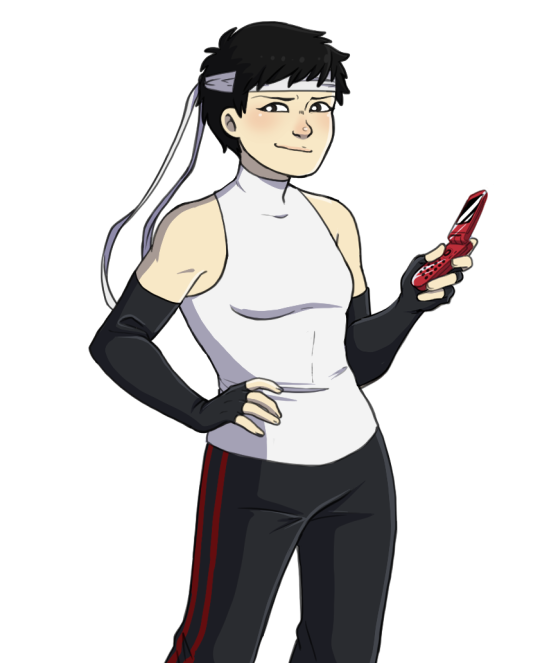
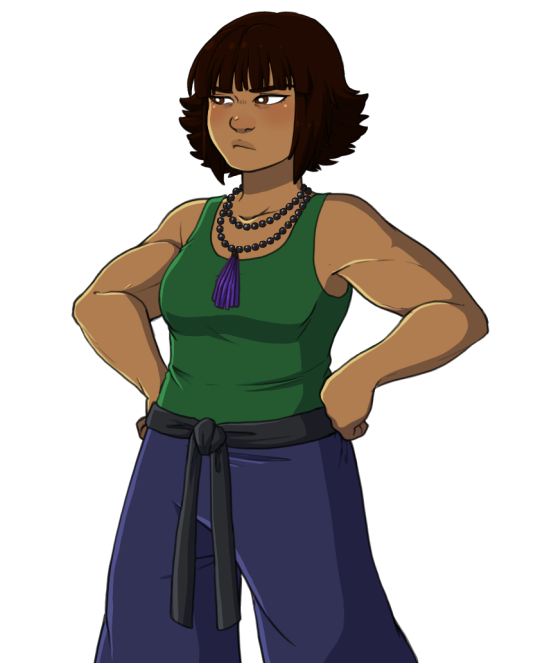
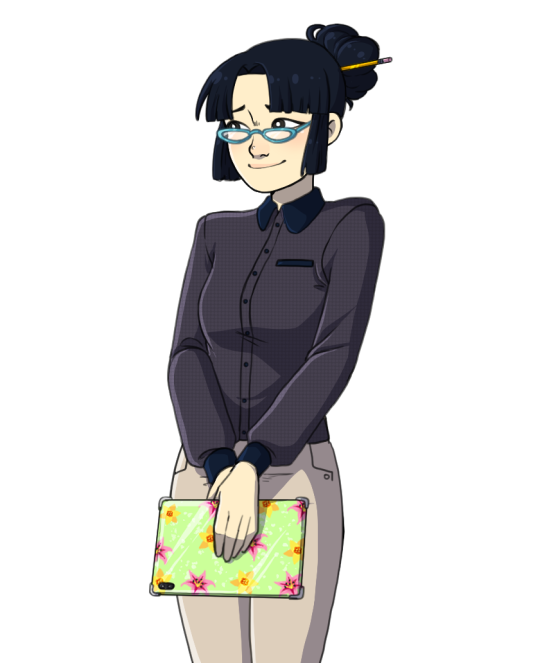
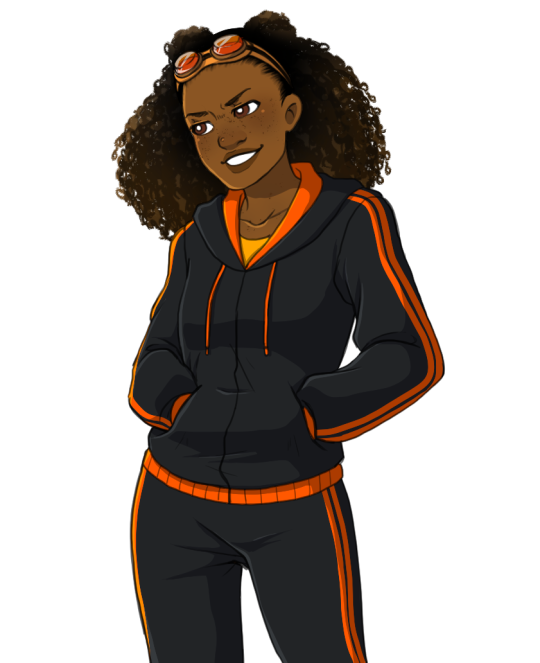
(all of the character art so far I have commissioned from my friend Hayley Sakura-Rose12)
I ended up deciding to have that sprite made when I implemented a whole text convo with Seiko near the end of Chapter 3. (or partway through the chapter, depending on what the reader chooses - OR they can even skip this conversation altogether, potentially)
The biggest updates to DRF lately have mostly been cosmetic: adding in more facial expressions and effects.
One example of this has been incorpating a more seamless and atmospheric effect for moments when Nishiko gets lost in thought.
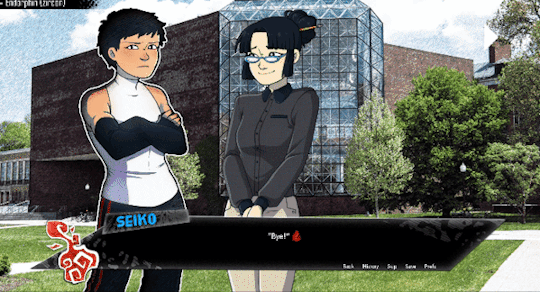
There will be a recurring and increasingly important component tied to this, so I'm glad Jenny helped inspire me to pursue this kind of idea. You can also see here a version of Nishiko's sprite which has been visually updated with more texture, alternate color, etc., and that's something she intends to do with the other characters when time allows (she's been very busy for like, over a year now).
Fire and smoke are key visual symbols for Nishiko's character, so Jenny has been helping me figure out ways to express this more through the UI, etc.
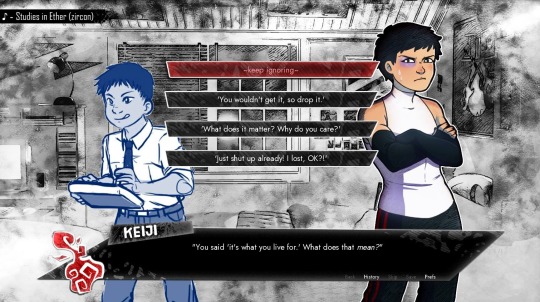
(my wife Jenny has worked on the UI, giving it a more gritty look, and she's modified Nishiko's sprite in this image to give extra atmosphere to the character sprites; she also took a placeholder image and did work on it to showcase a potential art style for the backgrounds; we're considering something like this, though maybe including more color, perhaps intentionally depending on the setting)
But it's not just been visual stuff. I've also been adding in extra content, and incorporating more choices and elements that affect and are affected by the stats running in the background.
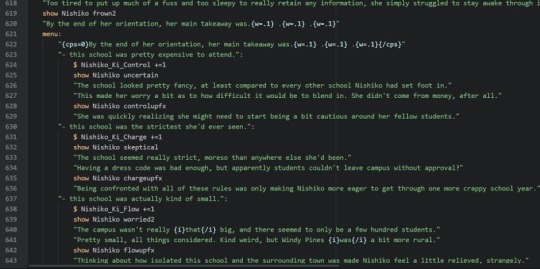
I've added in new short classroom scenes to help better illustrate Nishiko's experience inbetween social activities, while simultaneously using them to imply elements regarding Nishiko's attention span, as well as flesh out the lore of the world.

I've been a bit inspired by Tuca and Bertie in some weird ways, as well, trying to build lore within my own fighting game inspired world with references that double as, well, world building (like alluding to Street Fighter antagonist M. Bison via a political dictator who existed in this universe's history), including entire chunks of conversation that go in different branches based on weird Capcom humor that also serves to establish backstory.
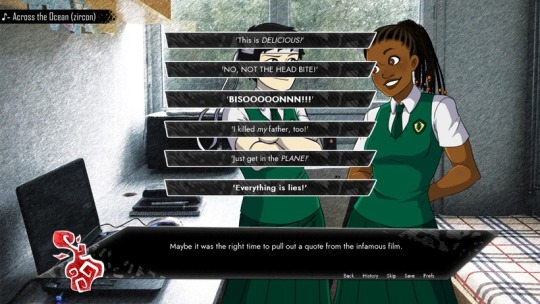
Nishiko and Kayla bond over love of a dumb cheesy horror flick that's essentially one big meme featuring the 90's Street Fighter cartoon. The drinks in the vending machines are all Capcom references, but serve as a means of letting the reader more manually increase a stat of their choosing - and since they're vending machines, they recur, so as the reader might get to know what each drink is, they might make a deliberate choice to increase a specific stat on purpose, in a similar way to choosing to exercise, or meditate, or study.
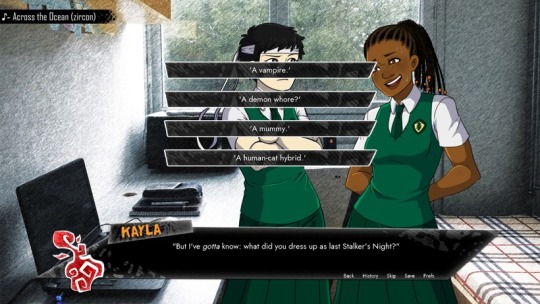
A convo about Nishiko's prior schoolyear incorporates Dark Stalkers references while also, again, letting the reader affect stats in a narratively retroactive way.
I've fleshed out conversations in Chapter 3 to have lots of dialogue most readers won't see in a single playthrough, as well as making more efforts to lean readers toward experiencing certain scenes or moments they might have missed earlier, while allowing the possibility of skipping or missing out on scenes entirely should they choose.
For example, the end of Chapter 3 is focused on Nishiko's relationship with Seiko. There is a text chat convo that can happen in one of two different parts of the chapter, and an in-person convo I'm currently working on (the last planned new content for the demo). Both can be experienced, or one or the other, or the can both be skipped. I don't want to make the entire social life something optional, but I do want to have there be parts like this where the reader can choose to skip interacting with a character if they truly don't want to, to help reinforce the idea that every interaction is, in a sense, a deliberate choice.
Even something like picking 'the BAD' choices is something I want to not just feel like, say, Undertale's infamous 'genocide run' but rather something that is an expression of anger at the world around the main character, which even has some specific benefits - because people don't just become jerks because they like to feel bad, but because it serves them in some beneficial way. As a slight example, if the reader pushes Nishiko to become aggressive, their 'Psycho' stat will increase, which can lead to them having even more aggressive choices later, which further increase that stat. But as that stat increase, Nishiko will become more physically perceptive to certain details about the world around them, but in material ways rather than social ways. For example, they might sense certain inklings of things that allude to later plot points earlier than someone who is more cooperative and might learn more social backstory elements. It's likely not going to be some huge, monumental difference, but it hopefully will make a second playthrough feel noticeably different and give the reader more insight into certain things.
The planned demo will feature the prologue and the first three chapters. By the end, all four main characters will be introduced, and the reader should get a pretty good idea through bits of writing and visual presentation that the choices they make won't change the primary narrative, but will affect certain details and aspects of how things play out. This is actually related to a big plot element itself that will become important later. But for now, it's been really fun adapting content I wrote over five years ago into this format, fleshing it out, and trying to work out ways to not only make that content function better in an interactive format, but also just how to lay more foundation and foreshadowing for what's to come.
While the visuals are still far from finalized even for this demo, I do have a private build uploaded for anyone genuinely interested, as I still haven't received much in the way of feedback so far. I'm planning on releasing a public demo to itchio later on when we can get the visuals to look more finalized.
12 notes
·
View notes
Note
Hello, what did you think of Baru Cormorant? I've been pondering about picking it up so it'd be nice to hear whether you enjoyed it
I’m actually struggling to describe what I liked about Baru Cormorant. There was no question in my mind, almost from the first chapter, how good it was---the slow start as an imperial power invades Baru’s home, transforming her family, her world, and what she sees as a future. (Baru chooses to go to the official imperial school, believing that she must learn the ways of empire in order to save her home; only later does she realize this is a poisoned cup.) And it only got better, from the sharply drawn character portraits of a hundred different individuals caught up in the empire’s games, including Baru herself, whose fatal flaw is that she forgets the chess pieces are also people. Add in a mid-act reversal of fortune, the late in the book plot twist, to the genuinely energizing finale, and what you have is something shocking, imo a masterwork.
I mean, one of the reasons that I’ve read so much over the last 3 months is because I’ve given myself permission to stop reading when I don’t like a book, or drop a series if uninterested in it. Baru Coromorant is the first series that I immediately went out and bought the 2nd book, reserving the 3rd through my local library. I loved it. I loved it.
(I’d also say that the second book, while less straightforward than the first in terms of plot, did a lot to expand the scope of the world and introduce a complex interplay of philosophy and varied cultures---while playing with some concepts about the more academic side of colonial violence.)
But what I really liked about Baru Coromorant was the horror and the suffering of it, and that makes it harder to discuss. Because this isn’t like some of the other books I’ve read recently, the monstrosity isn’t individual---the empire of Masquerade is genteel, and reasonable, and doesn’t hate or wish anyone ill. It’s just also a colonial empire, a vast machine churning out every kind of oppression, including violence, and silence, and death. It forces hard choices, and dismisses them in the same breath, offering explanation and excuse when you side with it. It doesn’t care for anything except itself and its own immortality.
It’s...uncomfortable, to be thrilled by plotwist because it is an unflinching choice by the author, an upping of the narrative stakes, yet simultaneously shows the naked power and inhumanity of a fictional empire. It doesn’t sit right to have characters interact with each other, each of them advocating for (1) eugenics, (2) White Man’s Burden-style benevolence, or (3) naked self-interest, and think oh wow this is a great book.
And I do think the series is good. It had me glued to my computer screen for 12 hours as I tore through 1000 pages of politics, economic tensions bleeding into politics, and various kinds of violent sacrifice on the altar of an uncaring empire. But I’m not sure how to resolve the tension between how much I liked its honesty, and what that might say about me. Or maybe it’s a mark of real quality, that a novel about being complicit in atrocities makes you complicit in them as well.
#from the bookshelf#I liked it so much it was so good the whole thing was phenomenal and bowled me over#but also I'm not sure you're supposed to be so delighted when#[SPOILER SPOILER SPOILER SPOILER]#or it turns out that there are [SPOILER SPOILER SPOILER SPOILERS]#which honestly is why I feel so strongly about the series#to have me feel this much ambivalence?#a week later to be thinking about the moral arithmetic that everyone is going through?#that has to be good#Anonymous
176 notes
·
View notes
Text
World’s End Club demo thoughts
As a follow-up to the ask I recently responded to, I downloaded and played through the demo for World’s End Club last night. It’s just a single level/chapter, and it didn’t take much more than an hour to complete it.
Overall, I really enjoyed it - primarily for how the “Game of Fate” unfurled across the first chapter. Said “Game of Fate” is the much-publicized Fake Death Game, and it centers around a setup that’s reminiscent of Danganronpa 3′s Future Arc. I’ll get into more detail much later after a Spoiler Cut, but suffice to say that everybody starts getting suspicious of one another immediately, and many betrayals occur in short order. The exact nature of how people would get knocked out of the game and why was what kept me most intrigued by the numerous cut scenes. Many people’s wristbands have rules that are tied in with other people’s rules, so there’s a domino effect of causality whenever someone is “eliminated” that quickly became my favorite part of the first chapter’s storytelling setup. Learning the reasons why someone suddenly teams up with a character they don’t get along with or why someone is eliminated for seemingly no reason? That’s a lot of fun.

Pielope the weird floating jester-like thing will be your Monokuma for the demo.
The characters are pretty thin as they are presented in this demo, but obviously it’s WAY too early to really know much about them. There’s even an end-of-demo twist that makes the characters’ behavior in this first level retroactively be even less revealing of their natures. The good news here is that everyone is well-voiced, and that helps them to be likable. Naturally, it’s particularly easy to grow fond of the characters who serve as a lifeline of kindness and sanity while the majority are betraying you.
Unfortunately, although most of the characters are voiced, there is one who isn’t: The protagonist that the player controls, Reycho. He’s one of those “silent protagonists” who isn’t silent at all; he talks, but the player simply never hears what he says. I’ve always disliked silent protagonists in games where everybody else is talking, so this just annoyed me, but it’s hardly a deal-breaker.
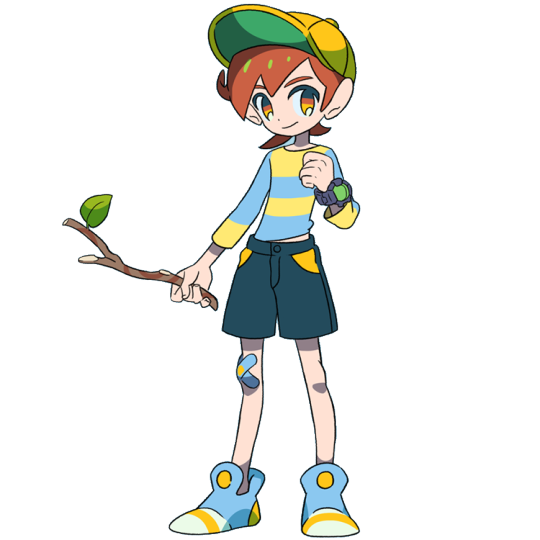
Perhaps he has laryngitis, and he’s communicating with surprising effectiveness by flapping his mouth and gesturing emphatically?
The first level consists more of cut scenes than actual side-scrolling gameplay, which is fine with me. Danganronpa games are similarly structured; you spend more time on the Visual Novel elements than on the interactive gameplay side, so this kind of balance is very much in my wheelhouse. Platforming is basically a non-issue in this chapter, and there were only three puzzles to solve in the entirety of the chapter, but hey, I liked them. One was painfully obvious, but the other two took me a little bit of thought. They’re far from hard IMO, but they took enough brain usage to make me feel good for figuring them out. The latest trailer reveals that future chapters will actually include boss fights (!), so that means we’re going to see some combat elements to the gameplay that aren’t even introduced in this demo. Sounds cool.
There are also a couple of “choices” you can make in the first level that can result in early Game Overs (with unique dialogue/scenes) if you do the wrong thing. If you’re a fan of games with multiple endings, I imagine that seeing all of the unique Game Overs could prove pretty entertaining, so this was another aspect I dug.
By the time the demo ends, there is still a ton of mystery around what’s happening in the game. That’s going to be the driving factor in keeping me invested, I suspect. Well, that and the voice acting. Both of those elements are what made me immediately wish I could go on to the next area.
If you want some kind of report on the technical aspects of the game, I can say that it’s got a cool soundtrack and the art style is appealing to me, but that stuff is subjective anyway. Character animations are frequently stiff and awkward, but who cares? If you’ve ever played Zero Escape’s latter two games, you should really expect that by now. :P And hell, the Danganronpa games aren’t animated at all most of the time, so let’s not act like we’re demanding some high-quality mocap in this sort of story. We’re here for the writing and characters more than anything, correct?
Now I’ll actually explain the setup of the “Game of Fate” so that I can complain a little about it. Spoilers for the demo/first level.
Here’s how the Game of Fate works in brief: The cast is trapped in an underwater building-type construct. Each member of the cast is wearing a digital wristband that tells them the “goal” of someone else in the cast. The only way to learn your own goal is to find the person wearing the wristband that states your goal. However, as soon as any one person accomplishes their goal, that person wins and "there can only be one winner,” so it’s probably in your best interest to keep your wristband hidden... if you assume that not winning means you’re automatically a loser. (Note that this is never outright stated by Pielope, although “there can only be one winner” could be argued as implying that the rest become losers.)
The winner gets a “magic key” that can unlock any lock, but it can only be used on a single lock before it “disappears.” Given that they are all trapped in this underwater prison, the obvious place to use the key is the exit door that leads to the surface. As for the losers who get eliminated by failing their goals or rendering them impossible, the cast is told that anyone who “loses” will die. But of course, the creators of the game have already spoiled us on the fact that this is a fake-out. In terms of in-universe logic, however, it makes for a frightening motivator for the kids.
The kids might have been too scared to spot them, but of course I, the player, immediately saw the loopholes here. 1) No one ever says or even implies that only one person can pass through the exit or anything. 2) People who simply don’t reach their goals first (but don’t render them impossible to complete) aren’t automatically called “losers.” Ergo, there is little reason why everybody wouldn’t immediately help one person to complete their goal so that they can all survive and unlock the exit, right? Just walk out the door together! Nobody manages to think of this, though. Alas.
In fairness... near the end of the level/demo, we are given some information hat could be seen as a retroactive explanation for why this didn’t just happen, and I was grateful for it.
#world's end club#world's end club demo#demos#tookyo games#video games#Kotaro Uchikoshi#kazutaka kodaka
15 notes
·
View notes
Text
a real witch reviews the arcana (aka that phone game based on tarot cards that keeps showing up on your explore page)

I’ve been seeing The Arcana all over Tumblr and Instagram for several months now, and since I am a Genuine Real Life Witch™️ and have been reading tarot for several years now, I thought it would be fun to play the game and review it both from a gamer perspective and a witch/tarot reader perspective.
Spoiler: I really, really like it.
Please note that I have done virtually no research into the developer or development history of this game. This review is based purely on my experience from my playthroughs.
So what is The Arcana?
The Arcana is a fantasy/romance visual novel created by Nix Hydra Games. A visual novel is an interactive, text-based story with static visuals, so it’s almost more like an interactive graphic novel than a video game. Honestly, visual novels remind me of those “Choose Your Own Adventure” books that were really popular in the 1980s and 1990s more than anything else.
(Note: I recently learned that a visual novel is NOT the same thing as a dating sim, although the two genres are similar and do sometimes overlap. Dating sims... simulate dating. That’s really all there is to them. Visual novels typically have a more plot-focused story, and may have other stuff going on besides the romance.)
The story of The Arcana follows the player character, a magician’s apprentice living in the fictional city-state of Vesuvia, who is enlisted to track down a suspected murderer. Where the story goes from there depends on which route you choose to play. There are currently six routes, each with a different love interest. Each route has its own unique story, although obviously there are some overlapping elements.
Sam the Gamer’s Review
Like I mentioned, The Arcana is essentially an interactive novel, so I’m reviewing it the way I’d review a book. So, let’s just run down some of the typical book review questions, shall we?
Is the content good? Yes. It has gotta be difficult to juggle six parallel storylines and make all of them equally compelling, but this game pulls it off. There were parts that genuinely had me in suspense, other parts that had me giggling at my phone, and some parts that were (intentionally) frustrating. I’m really impressed with how each route is totally different from the others -- not just in content, but even in tone. For example, Portia’s route comes across as much more lighthearted and fluffy, whereas Julian and Muriel both have a lot of angst in their respective stories. It’s really well done.
Are the characters well-rounded and realistic? Again, yes. Okay, “realistic” may be a bit of a stretch in some cases Vlastomil but all six of the main romanceable characters have fleshed out personalities that feel natural within the story world. The side characters in this game are also really interesting, although I do wish some of them had bigger roles in the story.
What about the technical stuff (dialogue, grammar, etc.)? For the most part, it’s pretty good. The dialogue flows naturally, and different characters have different speaking styles, which is a little thing that makes SUCH a big difference. I noticed a couple of typos, but nothing too crazy.
The gameplay was pretty good. The only real mechanic is choosing one of two or three dialogue options at certain points in the game. There are a couple of places in each route where these choices are timed, but other than that it’s a very stress-free gaming experience.
Another thing that impresses me from both a writing and a gameplay angle is the multiple ending mechanic. Your choices matter in this game. Each of the routes has an “upright” ending and a “reversed” ending. I’m not exactly sure which choices affect the ending you get, but I’ve only managed to get “upright” endings so far, and I didn’t have to do anything special to unlock them.
Sam the Witch/Tarot Reader’s Review
Honestly, I did not expect this game to be as accurate with its depiction of magick and the Tarot as it was.
Each character is based on one of the Major Arcana, and I feel like they did a really good job of matching their personalities to their cards. Nadia is based on the High Priestess so she’s very intuitive and intelligent but tends to be distant and hard to read, Julian is based on the Hanged Man so he feels the need to sacrifice himself for others (with lots of gallows humor along the way), Lucio is based on the Devil so he’s a fucking bitch all about power and excess, etc.
I reeeeaaalllyy like the use of “upright” and “reversed” endings instead of the typical good vs. bad endings -- based on upright vs. reversed meanings of Tarot cards, of course. I also really love that the reversed endings aren’t 100% negative, just like how reversed cards in readings aren’t necessarily negative.
I don’t wanna spoil anything, but I also really like how the upright endings deal with the upright traits of that character’s Major Arcana card, while the reversed endings deal with the reversed traits of that card.
This game also includes some pretty realistic depictions of witchcraft and magick. Obviously because it’s a fantasy world there is fantasy magic involved, but astral travel is a major theme in pretty much every route, and the way it’s depicted in the game is very similar to my real life experiences with it.
There’s one character who is a kitchen witch and makes homemade enchanted food with magickal herbs, which made me feel warm and fuzzy because it reminded me of all the times I’ve used kitchen magick to make charmed food for myself and my loved ones.
Tarot readings are obviously a big deal within the story world, but there’s also a character who uses runestones! Which I think is neat!!
They mention some real-life magickal plants. Myrrh being used for protection comes up a lot, which, in case anyone was curious, is actually one of the common uses for myrrh in spellcraft.
They clearly did their research and honestly I’m thrilled.
Other Cool Stuff About This Game
It’s probably the most queer-inclusive video game I’ve ever played. Right off the bat, you’re given the choice to choose between he/him, she/her, or they/them pronouns for your character. The pronouns you pick do not affect the story in any way.
All six love interests are romanceable no matter what gender you play as. Which means this is canonically a universe in which everyone is queer. Hell yeah.
Two of the six current romanceable characters are women, and one is nonbinary. The routes for these characters are just as well written and romantic, with just as many wink-wink-nudge-nudge innuendos, as the men’s. There are also multiple nonbinary side characters.
Also! Racial and ethnic diversity in the main cast! And the main characters all have different body types, which is another nice touch.
This is nerdy as hell but I love how the different cultures and ethnic groups in the game are based on real-life cultures? It’s just one of those little things that makes my heart happy.
The art style is pretty as fuck.
In conclusion: I feel like this review is overwhelmingly positive but I just genuinely can’t think of any major criticisms of this game. It’s fun, it’s free, there was clearly a lot of thought put into it. I was really pleasantly surprised. Everybody go download it and play it. You’ll have a good time, and afterwards you’ll understand all the memes.
P.S. I know people are gonna ask so: I chose Julian for my first playthrough because he’s tall and goth and has messy hair and that’s honestly all I look for in a man. Now that I’ve played all six routes, Portia’s is probably my favorite because it’s so cute and wholesome and I just really want a soft bookworm girlfriend, please. Lucio’s route is a close second because after seeing him as an antagonist in everyone else’s routes it’s actually really interesting to see his story told from a sympathetic angle! But like I said, I’ve played all six routes.
#i was gonna make this review a youtube video#but i think it works better with this format#anyways i love this game#the arcana#visual novel#tarot#tarot cards#tarot reader#witch#witchblr#video games#queer#lgbtq+#lgbt#wlw#mlm#video game review#the arcana julian#the arcana asra#the arcana nadia#the arcana portia#the arcana muriel#the arcana lucio#the arcana paid scenes#witchy#magick#mine
1K notes
·
View notes
Photo
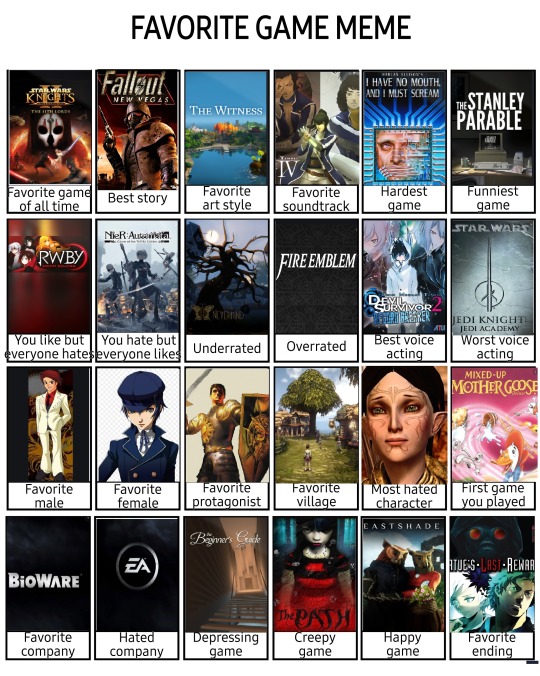
I saw this bouncing around my dash and decided to fill it out myself for fun :) I decided to not double-list any games, and I tried to mix up the companies I used too so that the list would be more unique.
Long post, so I’m doing a readmore for my longwinded part lol.
(read more)
Favorite Game: Star Wars: Knights of the Old Republic 2: The Sith Lords - I could talk about this game forever. How it tears apart the Star Wars universe from within, how it creates a compelling story while challenging the usual themes, etc. I could talk for ages about the characters and how their motivations slot in place, and how this game lends itself to interpretation and analysis alongside roleplay. It’s just a wonderful game, one I deeply love and will always love. It’s a game that isn’t afraid to have you talk to other characters for twenty or thirty minutes at a time and honestly I’m always riveted at every line. This game deserves the cult fanbase it has, but I think there’s a lot the fanbase misses in appreciating this game. (Note...gameplay is a little janky and a community made mod restores a lot content that was cut before shipping-the game wasn’t properly finished).
Best Story: Fallout New Vegas - It’s the setting that makes the story here, and all the moving pieces and factions alongside the main conflict really make this game stand out. There’s so many little pieces to find along the way in the world and the way the main quest splits based on who you want in power feels important--and you are choosing a future for this whole region.
Favorite Art Style: The Witness - This game is peacefully wonderful with its visuals. There are wonderful nature scenes and nests of wires and panels spreading in various parts of the island that are fascinating to look at. The environment is half of the gameplay in most areas, so it’s important to look around even though exploration is not really the gameplay. You find puzzles in the world, even in nature, and it’s fascinating. The colors are bright and beautiful. There is even a map in the middle of the island inside of a lake that helps you track your progress if you notice it (it isn’t like a normal ‘map’).
Favorite Soundtrack: Shin Megami Tensei IV - I love video game soundtracks, but SMTIV is something special. The music booms in ways that make you really understand the atmosphere of the world, and there’s a great mix of different kinds of tracks for different places. I love the tracks for the other worlds you enter, and the themes of the different routes are done so well. Some of the music draws from past SMT games, but the remixes done for this game really are stunning to me, and there’s so many fantastic original tracks.
Hardest Game: I Have No Mouth and I Must Scream - I love this game but I literally never touch it without a walkthrough, which is why it gets to be the hardest game on the list, despite being a point and click adventure game lol. Also just emotionally this game is challenging too, but I definitely mean this more in terms of getting a ‘perfect run’.
Funniest Game: The Stanley Parable - Trying to make this list has taught me that I don’t really play many ‘funny games’. I don’t know if a game where multiple endings demand that you kill yourself should count as a ‘funniest game’, but it is also a game where the narrator tells you to stare at a fern and memorize its features, so....it counts.
Game I Like that is Hated: RWBY Grimm Eclipse - I’ve been playing this game since it was in early access and have loved it the whole time. I find the gameplay soothing and fun, and I like playing the different characters. It’s a game I play to chill out and just enjoy some fun battle mechanics. It’s a fun game and I’ve spent over 100 hours in it, so I hope I like it, lol.
Game I Hate that is Liked: Nier Automata - Neither this game’s gameplay or story impress me, and the fact that you have to replay basically the same stuff from a more boring-to-play-character’s pov in order to SEE all of the plot is a huge damper on the experience. The story, to me, someone who engages with a lot of robot-focused fiction, is far from impressive or new, and it hardly engages with genre specifics at all, let alone in a new or interesting way. I view this game as ‘a story with robots in it’ rather than ‘a story about robots’, which, to me, is a detriment.
Underrated: Nevermind - This game is amazing and very unheard of--and when it is heard of, it has been marketed incorrectly. Nevermind seems like a horror game, and does market itself as one a bit, but it’s much more than that. It’s more about trauma, recovery, therapy, etc. This is a game that is so mindful about the topics it engages in that I am impressed by it every time. It’s heavy with symbolism and character, despite lacking conversations or other similar game mechanics. This is a lovely game that I really wish more people knew about-`p5-all of the patients are so interesting, and the focus on recovery and mental health is impressive.
Overrated: Fire Emblem - I sort of mean this as the series as a whole really. I have enjoyed the entries I have played somewhat, but I overall consider the series much less impressive than I was led to believe by others. The gameplay especially is not impressive to me in any regard, even though I sometimes do find myself enjoying it. The stories are alright, but many of them are weighed down by the gameplay and as a writer and person who likes to analyze writing, it’s very hard to do so when it isn’t able to fully exist under the chains the gameplay forces on it. There are ways to mix gameplay and story well, Fire Emblem has not really done that in any of the entries I’ve played. That being said, I don’t regret playing them, and I will occasionally replay, but I consider them mediocre games at best.
Best Voice Acting: Devil Survivor 2 - I love the voice acting in this game. I feel like all the characters are really suited to their voices, and it’s really easy for me to visualize their voices. They really bring the game to life and make both the dramatic and the funny scenes more enjoyable.
Worst Voice Acting: Jedi Knight Jedi Academy - I love this game, I really do, but some of the voice acting is janky. Some of it is okay too--I think Kyle Katarn’s voice actor does fine, and some of the others I like NOW but hated when I was a kid, but the male protagonist voice in this game is just awful. Which is bad when Jennifer Hale is the female voice actress lol. His performance is passable though unless you’re playing darksided--the darksided ending to the game lacks all punch when you’re playing the male protagonist.
Favorite Male: Battler Ushiromiya from Umineko no Naku Koro Ni - He’s the protagonist for most of the visual novels and I adore him utterly, especially once you move past episode 2. He’s a wonderful character who I care about deeply. I love his drive and how he fights--he’s someone who is easy to cheer for. He matures well throughout the series and his character development is just wonderful.
Favorite Female: Naoto Shirogane from Persona 4 - I really like how Naoto fits so well in the game, especially for being a final recruit--oftentimes the final recruit of Persona games (post 3) have a bit of a more difficult time feeling right with the group. Naoto works really well though, and I love her struggles and story as well. I think the difficulties she has concerning living as a woman in her field hit very deep to a problem that has existed for a very long time.
Favorite Protagonist: Connor of Daventry from King’s Quest 8 Mask of Eternity - I’m like, one of four fans of this character in the world, lol. KQ8 is not a very well liked game and it does have a lot of issues, both with age and with how much of a departure it is from the series prior to it. It’s strange to take a puzzle adventure game and make it a hybrid with what basically is a shooter, and it doesn’t really work. Add to that the fact that you spend most of your time in the game without anyone around to talk to and it leads to this really polarizing and weird experience. For me, Conner goes through what I would consider to be the ‘Ultimate Nightmare Scenario”. Everyone in the world is turned to stone except him (and he survived out of mere chance) and so now it’s up to him, practically alone, to save the entire world. There is no game lonelier than this. I adore him for his bravery in the face of it, and how he just picks up to do what must be done because someone should do it, and if no one else can, then he will. I also really love how he apologizes to people who are encased in stone while he takes money from their houses to help him on his journey. I really do think he went back after the game was over and gave everyone heaps of gold to pay them back with interest lol.
Favorite Village: Oakvale from Fable - The first Fable is the only one I really like, and it was one of the games I played when I was little, so the hometown in the game always meant a lot to me. I like how you grow up there and how your tragic backstory is there--and then how you get to return to the town years later after you’ve come into your own, and you can see it completely rebuilt. I like to spend a lot of my time in this town, just wandering around it and playing the minigames. Even though I have a house in every town, Oakvale is where my hero calls home.
Most Hated Character: Merril from Dragon Age 2 - I don’t really want to lay into how I feel about Merril, but what I will say is that it was suggested to me that I totally ignore her when playing, and I did so. I only met her for her quest, dropped her off in town, and literally never spoke to her or interacted for the rest of the game. I had a much better experience for it, honestly. She appeared after I made my choice in the end of the game, which felt weird since I hadn’t spoken to her in several ingame years, but other than that, the game was totally fine without her. I sort of just wish you could kill characters in DA2 the way you can in DAO, then I’d just do that, tbh. It doesn’t suit very many (or any) of the characters I rp in DA2 to keep her around or support her in any way.
First Game I Played: Mixed up Mother Goose Deluxe - I’m not actually sure if this is the FIRST game I’ve ever played or not, but it’s one of the first I played alone as a kid. I really loved it--this is probably what created my love for point and click adventures, and the game was very silly and fun.
Favorite Company: Bioware - I’ve always been a sucker for Bioware games, ever since Knights of the Old Republic 1 was my favorite childhood game. I love how they do stories and party members, and while I’m not a fan of all of their games, I really love what they’ve made and their style of storytelling and character driven plot. Even though sometimes their stories get cliche, I think the suit video games well and most of my early gaming was within their games.
Hated Company: EA - Bioware truly only started to go to shit after the EA acquisition, so I fucking hate EA. I know Bioware had issues before EA too, but I definitely don’t think EA has helped the situation whatsoever.
Depressing Game: The Beginner’s Guide - I relate to this game as a creator and a writer, and it affects me deeply because of the story it tells and the questions it raises. It makes me reflect on how I think of myself as a creator, and it reminds me of friendships I used to have.
Creepy Game: The Path - God, I love this game. It’s just aimlessly wandering around and finding symbolic scenery and watching your current character comment on it. Then, you go off to find your girl’s wolf, and each one is different and unique to her, and you watch it ‘kill’ her--and facing her wolf is the only way each girl can truly mature. Whenever you get to grandmother’s house, the camera switches to first person, and your eyes keep closing, so you can only see while clicking to move. It forces you to keep moving so that you can see, but since you are moving, you only get to see things somewhat vaguely. It’s got a great atmosphere, and I love the symbolic storytelling.
Happy Game: Eastshade - This game is so sweet. There’s some drama around to with many of the quests, but I like this as an rpg without combat, and I think this would be a really good kids game. There’s a lot to see and explore, and the game was made to be really pretty so that you want to paint several aspects of it. It’s really lovely to just wander around in this game and bike around the area, painting anything that suits your fancy. As long as you don’t finish the main quest, you’re free to wander, and materials do respawn, so you essentially can infinitely paint once you get far enough.
Favorite Ending: Virtue’s Last Reward - I love the questions this game asks and where the ending goes. It thematically ties together--the whole reason the game itself exists is to get the attention of a ‘higher being’--the player, essentially. I love how it plays with that concept, and even though the final game in the series doesn’t entirely pick this idea up where this game left it, standalone this game is stunning in how it comes together.
#shitpost#long post#this was fun to do#i made it so every answer was a different video game and i tried to mix up my companies as well#got 3 atlus games on here but mer#2 obsidon#llol#2 sierra too haha but still#beginner's guide and tsp were made by the same guy too but#STILL I LIMITED MYSELF OK#these answers aren't absolute because i was trying to have a good diverse list lol
9 notes
·
View notes
Text
me playing “Ebon Light”
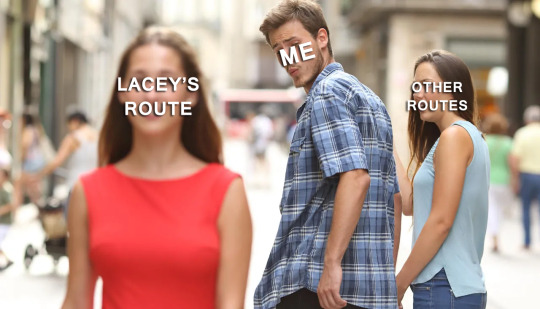
every. fucking. time. I’ve got so much unchecked playthrough options and so many plot branches but no, I just can’t help myself lol. love that scoundrel to heart attack. my favorite trop with antagonistic dynamics *chef’s kiss*
For acquaintance, “Ebon Light” is amazing dark fantasy visual novel from @underbliss. Highly recommend to play to anyone who likes complex plots, interactive story development, which depend of your choices, that are really matter here - they not only define your MC’s personality and skills, that in turn makes possible or not to successfully perform some further actions, but also affect the direction where the story will go. And this is really exciting - when in my first playthrough I've suddenly found MC got killed, I was like "WHAAAA-- What just happened??" It was shockingly unexpected but cool :) It is really a pleasure to play and discover new plot branches. And of course there are just awesome characters - both LIs and all other side chars. I think it is my first VN where I really felt interest in making MCs with different personalities and behaviours for different LI to disclose the whole potentional dynamic of their relationship and just interactions to gather information that they can share with protag. And what is also important for VN - it is really beautifully created. Visual part as sprites and backgrounds is an aesthetical delight *__* Love artist's style very much! (and feel nostalgic pain in area of emo times juvenility lol) I’ve spent several days playing it, feel that I really have a lot left unnoticed that I'll keep checking. And this game definitely worth every spent minute.
25 notes
·
View notes
Text
Level Up! Upcycling an Intermediate App
Hello friends and welcome to another unsolicited writing tutorial, aka my bread and butter! Today we’re going to build off of ground covered in my earlier tutorial, Level Up! Beginner/Intermediate/Advanced RP and You.
As always, I’d like to point out that there is nothing wrong with being a writer more naturally suited for intermediate sites! But if you’re looking to write in the more ~advanced or ~literary space, you will need to adjust your writing to fit the community standard. While your writing will likely improve over time as you write with more advanced writers, step one to threading in such a community is getting an app accepted there.
In today’s tutorial, I’ll be talking about how to revise an existing intermediate application to make it more suited for an advanced site. Let’s begin!
As a staffer on an advanced site, the note I most often have for applications that we pend or decline is: this feels very telly.
I don’t mean “telly” as in Telly the Sesame Street character:
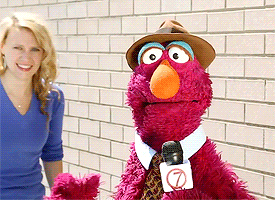
I mean “telly” as in extraordinarily expository.
An intermediate freestyle application often looks like a straight-up timeline of a character’s history, delivered without much style or voice. It might feel like a Wikipedia article, or a very long explanation like you might see in a shipper.
I often find that it can help streamline the writing process to write a handful of telling anecdotes, rather than rehashing a character’s complete history, infancy to present. More on that in my freestyle application tutorial here!
But if you’re having a hard time wrapping your head around anecdotal-style applications, particularly if you’re accustomed to application formats that have you write a “history” section as opposed to a freestyle, you can improve upon your current app to make it more suited for an advanced site. It will take some work, and certainly more than ten minutes of it. Writing on a “reach” site can be very rewarding, but only if you’re willing to put in the effort.
TELLING
Before we solve the problem of “telly” writing, we need to establish what “telly” writing is. For purposes of this tutorial, I’ll be using my one application that is a full rehashing of character history. Below is a “telly” take on Sadie Shunpike:
Sadie grew up in a working-class neighborhood of London with her twin brother, Sam. Neither of her parents were very good at magic, but hid their insecurity in the belief that any magic at all made them better than their Muggle neighbors. Sadie and Sam weren’t educated at the local primary school, but were homeschooled by their mother until they could read. From there, Sadie and Sam would check out books from the local library and teach themselves, with Sadie helping Sam.
Sadie was very smart, but Sam struggled more with learning. As they got older, Sadie started to read books she ordered from Flourish and Blott’s, learning about magical theory. Sam started to show signs of magic, which he hid from Sadie. When they turned eleven, it became clear that Sadie was a squib. She resented Sam for being magical, especially when he went to Hogwarts and needed Sadie’s help to do his homework. Sadie continued to educate herself.
Sadie developed an interest in the Dark Arts and got mixed up with Death Eaters in a research and study group she attended at Flourish and Blott’s. One of them promised her a Ministry job and ensured her safety if she acted as a spy in the Ministry for the Death Eaters. Later, she got placed into a safehouse, and began to spy on the safehouse network for the Death Eaters.
This tells you a lot about what Sadie has been up to, but doesn’t tell you much about Sadie, or about my skill as a writer, or about how someone else might expect Sadie to behave in threads. There is no voice, no personality, no interest - just rote explanation.
As a staffer on an advanced site, when I see an app like the above, I know I will be pending or declining the application. The question I ask when making that distinction is: is the character development strong enough to merit working with the writer on the prose? Is the prose strong enough to merit working with the writer on the character development?
If the writing itself or the character development is there, it can make sense to help guide the writer - though this is more the case with character development issues than with prose. Character development can be improved with specific notes and adjustments, whereas generally speaking, improving prose is a gradual process over time.
It is entirely possible that a writer might have much better prose in their threads than in their application! However, your application serves here as a writing sample. which is why it is imperative that it be good writing on its own. I have said it before and I will say it again: I don’t care how much you hate writing apps, lmao! You’ve got to write a good one if you want to do well on sites that use them!
SHOWING
Writing communities are always talking about show vs. tell. Unless you’re writing stage directions, it is always better to show than to tell - or at least, there aren’t enough exceptions to the rule that you shouldn’t be aiming primarily to show.
So how do you communicate a character history without making it too telly?
DESCRIPTION
Here, I’ve described Sadie’s neighborhood as “working-class” and left it at that. What if I went into a little more detail? Explained to you what I imagine when I imagine her upbringing, and shared with you what’s going on in my head between the lines?
In a small, shabby house in a small, shabby suburb, a small and shabby family lives a small and shabby life. Samuel Shunpike, Sr. sells advertisements for the Daily Prophet, tossing a handful of Floo powder into the minuscule fireplace in the sitting room every morning and getting ash on the threadbare round braided rug every night.
This has more flavor, doesn’t it? The repetition of “small, shabby” is a deliberate style choice that communicates an idea of how I write in practice when I’m being ~artsy, and the image of a man in a shabby suit crawling into his fireplace and messing up an already messed-up rug builds Sadie’s father as an NPC that will come into play later in her app. Dynamic NPCs - whose actions impact your character, who are more than wooden cutouts - help build the fictional world of your character’s life. They don’t even need to be vital to playing your character - I’ve never really had anyone in Sadie’s family in play onsite, despite how heavily her brother figures into her character development - but they can be very useful in understanding your character.
DIALOGUE
Ha, irony, that dialogue can make an app less telly! Dialogue gives your reader an idea of how your character interacts with the world in concrete situations, not merely in the abstract. It also helps build the dynamic NPCs that make your character’s history feel more real, and feel like something that genuinely impacted them rather than something manufactured for plot.
While the Shunpikes are nobodies in the circle of wizarding society, Margie and Samuel Sr take comfort in the fact that they do have one thing making them better than the Muggles who live the small shabby lives on either side of them: the Shunpikes are magic. small, shabby magic, but magic nevertheless. "You lot are better than this," Margie says, smoking a pipe on the stoop, gesturing at the sidewalk where children walk to school with their parents. Sam and Sadie don't take their eyes off their Exploding Snap game. It's no use arguing with Margie, they know. When she goes inside, grumbling about Muggle trash, Sam and Sadie train their eyes on the walk outside. The parade of children their age, all wearing matching khakis and polo shirts. "What do you think they get up to?" Sam asks, glancing at Sadie. "Same as us, i imagine," she says, "but probably, y'know, more guided."
This brief vignette tells us a few things:
Margie Shunpike, Sadie’s mother, is mean, and relies on what little magic she has to feel like she has worth
Sam looks to Sadie for leadership/guidance
Neither of these are specifically about Sadie, but having this background information about her mother seen in action rather than merely mentioned will impact how we digest the news that Sadie is a squib. Sam, as a recurring NPC, will inform how we see Sadie develop, and seeing his changing relationship with her will give another metric for the reader of how Sadie has changed.
DETAILS
Details build your world, make it feel more real. When I wrote earlier that Sadie ordered books from Flourish & Blott’s, they could have been any books - they could have been the magical equivalent of ABC “First Concept” books - they could have been magical erotica. Don’t details tell you a lot about a person? If I tell you that Renee Rye Bread reads 50 books a year, what have you learned about her? What if I clarify that it’s 50 romance novels? 50 crime dramas? 50 political biographies?
When Sam and Sadie were younger, Margie would sit them together at the kitchen table and clumsily teach them letters and numbers. Once they could put together sentences and basic sums, she happily stepped back and let them figure it out on their own. On an average day, Sam and Sadie will watch the parade of schoolchildren, finish a game of Exploding Snap or Wizard's Chess, eat an early lunch, and spend the rest of the day doing their best to get an education. Sadie tries the hardest, dragging Sam with her to the Muggle library around the corner to read Muggle fiction and do basic research on whatever catches her fancy. She saves her allowance and coins from doing chores for the neighbors and orders secondhand books from the Flourish & Blotts catalog, poring over wizarding texts and trying to make sense of magic beyond even her parents' meager skill. Sam sometimes gives her his sickles, too. He isn't doing anything with them, and everything makes more sense with her in charge.
These details - what Sadie and Sam’s homeschooling looks like, Sadie’s attitude towards books and learning, Sam’s support in her academic endeavors - are building blocks in your understanding of Sadie’s personality. She is driven, self-directed, curious. She doesn’t ask Sam for his input. She is, perhaps, a little selfish.
DIORAMA
Trying to keep to a “D” theme here for an easy mnemonic device here! What I mean by “diorama” is that even in an app not specifically built around anecdotes it is good to provide a few key slices of the character’s life - a clear window into specific scenes and moments. What strikes you as more impactful: me telling you, “there’s a scene in Heathers (1988) where Veronica’s boyfriend has put a bomb under the bleachers during a pep rally. It’s fine, it doesn’t go off,” or me describing to you: “the gym is full of stamping feet and shouting cheerleaders; no one could hear Veronica and JD fighting under the stands even if they were interested. The bomb is beeping so loudly but no one is paying attention, no one can hear it. It’s a pep rally and everyone is cheering at their own wake.”
Rather than saying:
Sam started to show signs of magic, which he hid from Sadie. When they turned eleven, it became clear that Sadie was a squib. She resented Sam for being magical, especially when he went to Hogwarts and needed Sadie’s help to do his homework. Sadie continued to educate herself.
I went with the below:
In June, Sam is sitting in the kitchen while Sadie makes a solo trip to the library, folding paper airplanes and flying them with no success. After a dozen failures, however, he watches in amazement as a piece of notebook paper folds itself up into a perfect airplane and flies around the room on its own. He's done magic, and he has no idea how. And he keeps it a secret from his parents, but more importantly, from Sadie, who he now knows is not going to be coming with him to Hogwarts after all. Later that week, while the family is tucking into ham sandwiches for dinner, the owl arrives, and Sam's stomach sinks when Sadie proudly carries it from the sitting room window into the kitchen on her forearm. She unties the letter from its leg, looks at the front of the envelope, grinning. Samuel Sr and Margie see a shadow pass over their daughter's face for half a heartbeat before she slowly hands the envelope to her brother. But Sam sees it all: her smile cracking like broken china, her eyes widen just a little, the furrow in her eyebrow. He catches the hitch in her voice as she congratulates him. He senses her anxiety in the lightspeed jiggle of her left foot under the table, as he stares at the letter, unable to make sense of the words, as worried as he is about Sadie. She excuses herself early, and Samuel Sr and Margie exchange a look, as if they've forgotten Sam is there. Sam doesn't know what any of them were expecting, but it wasn't this. The next few days, during which Sadie does not speak to him at all, are the longest of his life. Then, one morning, as he sits at the kitchen table having a silent breakfast with Samuel Sr and Margie - who are still flabbergasted to have a squib in the family - she comes down the stairs from their shared attic bedroom. She sits across from Sam at the table as if nothing has happened. She helps herself to a slice of toast from the stack on a plate in the middle of the table, and takes a piece of bacon off Sam's plate. "Since i won't be going to Hogwarts as expected," she says, folding the toast to make a sandwich and taking an enormous bite, "I'll need to arrange for a more formal education.” She swallows her bite and pours herself a glass of orange juice. “I’m happy with our current method of self-directed study, of course, but - i intend to supplement it with the odd lecture or class audit in the city.”
We get a few things here:
Sam’s anxiety/guilt about being the magical one, a dynamic that informs how Sadie will use him later
Sadie quickly hiding her actual emotions and performing fake ones, which comes up later when she manipulates people at the Ministry and in safehouses as a spy for the Death Eaters
Sadie’s decision making, which doesn’t allow room for input, feedback, or disagreement
Think of your favorite books and characters. If a novelist gave you a quick description of a character in one paragraph, you wouldn’t feel the close connection to them that you feel after reading even just a few chapters of them acting, reacting, interacting. Of course we don’t have as much time for that in an app as we do in a novel, but there’s a happy medium between the shallow understanding we get from pure exposition and the deep one we get from 50,000 words and a hardcover.
IN PRACTICE: HOW DO???
So we’ve got our intermediate app. We’ve got our Four D’s: Description, Dialogue, Details, Diorama. We’ve got an advanced site we are lusting over.
How do we Frankenstein this all together?
STEP ONE: REREAD YOUR ORIGINAL APP
Give her a look. Get the basics in your head. Think about how you might be able to repurpose this writing for your shipper. Because, hey! It’s already done! And at least in my experience on advanced sites, shippers are a TL;DR for your app, so a quick expository jaunt through the highlights fits the bill just peachy.
But you’re not going to be able to work from that app directly for version two, okay? Be honest with yourself. How much do you ever revise things? Because this isn’t a “change a word, add one (1) sentence,” project. This is an overhaul.
Like I’ve said! Going from intermediate to advanced is HARD WORK!
STEP TWO: GET WRITING
Start writing that app from scratch. Think about the Four D’s.
If you’re approaching this as a straight history of your character, have at it wherever you want to get started. But before you move on to the next phase, address your Four D’s.
Susie was a difficult baby.
STOP! Give me the D. Was her nursery hyperfeminine? Did her nannies gossip about her parents behind their backs? Was Susie a fussy baby, or was she sickly? Show me her cold and distant mother awkwardly holding her before passing her off to her father!
If none of these D’s feel important to this phase of the character’s life: don’t include it in the app! A character history does not need to cover every minute! You can just hit the important phases, and you should! Believe me: staff usually do not want to hear about how mom and dad met each other unless it actually has a major bearing on Susie’s life!
Once you’ve given the moment its due (Due, the fifth D), move on to the next, and consider the D’s every time.
STEP THREE: REREAD & REVISE
Before you submit your app, give it another look. You’ve likely done a lot of character development between your original application and the fully-overhauled version. Is your characterization consistent? Do your character’s motives make sense? Have you left any gaping holes in their story? Look back at your shipper, especially if you used your original application to build it out. Does it align with the new application? What edits do you need on the shipper to have it describe the same person as your app?
STEP FOUR: PROFIT
Obviously, as with anything else, your mileage may vary. It might take a few tries, or even a few different characters to land on something that works for an advanced site. But the practice of implementing the five D’s - and keeping them in mind subsequently as you post with and develop your character - will be instrumental in growing your abilities as a writer, and isn’t that what this is all about? Wishing you all the best in writing as in life - let me know how you’re doing, and what other tutorials you’d like to see from me. Cheers, and happy writing!
7 notes
·
View notes
Text
Deciding on a POV
There are many ways to tell a story, and each one comes with a benefit or a downside. Still, I figured it’s worth going over the different ways each can be effective.
First Person
Reliable Narrator: A story with a reliable First Person narrator is one of the most common narrative styles. What this means is that the reader can trust what the narrator is telling them is the truth as it actually happened. Think Percy Jackson in the Percy Jackson and the Olympians Series.The reliable narrator is far more common than the unreliable variety. The benefit of this narrative style is that it mirrors how we tell stories verbally. If something happened to me, and I tell my friend what happened, I am going to use First Person narration to explain the events that transpired. Thus, this can feel like the most organic option. It also allows for total access to the POV character’s thoughts, allowing readers to see how they reached a conclusion, or why they’re acting a certain way. However, this can come with the problem of not being able to get inside the head of anyone except for the narrator. Now, while it’s standard for the First Person narrator to be the main character, it isn’t always the case. If the narrator is some sort of omniscient, bystander, or divine presence, whether they interact with the characters or not, it technically falls under First Person if they voice their opinion using I statements. The figure of Death in The Book Thief is a good example of this, as Death uses I and me in the narrative of the story. Because the story is set in Germany during World War II, the narrator of Death sees the protagonist, Liesel, frequently, and thus we’re able to get a narrator who is observing a protagonist from outside of her immediate story.
Unreliable Narrator: An Unreliable narrator is going to be the exact opposite. They tell the story, but take their story with a grain of salt. Whether their perception of reality is distorted, they’re using metaphors and symbolic imagery to tell the story, or they’re telling the story from a very narrow viewpoint, the unreliable narrator can be a good choice to get the reader to engage with the story and think critically about the work. Rugrats is a good example of this type of storytelling, as the main characters are babies, and therefore often mistake things for something else, making them unreliable narrators. This type works well if you want to tell a more abstract story. For instance, an entire story is about a boy chasing after a red balloon, but that red balloon itself represents accepting his mother’s death. Suddenly everything experienced becomes unreliable, leaving the reader wondering if the foes he defeated or the desert he crossed was literal, and he went on an actual journey to come to terms with his mother’s death, or was everything figurative, and the journey was more symbolic and allegorical? An unreliable narrator can play with these questions, blur the lines between reality and fiction, and leave their readers asking questions.
Third Person
Omniscient: Lemony Snicket is a perfect example of a great omniscient narrator. Mr. Snicket knows everything about every character, knows what’s going to happen before it happens, and comments on everything. Lemony Snicket himself is not a character in the story. Rather he recounts the story much like the First Person style, but from an outside perspective. Instead of being part of the story, Lemony Snicket is telling us about the Baudelaire children through the lens of the all-knowing and opinionated narrator. It’s not entirely uncommon for this type of narrator to be some supernatural force, a wise old sage, or someone who lived through an experience recounting the tale many years later. In fact it could be rather fun to play with this last one, having the story almost be told like a myth or legend, but having the narrator constantly side track to discuss how historians know and gathered the information for this story, only to reveal the narrator isn’t some omniscient being, but just a docent in a museum giving a tour and explaining an old myth to the patrons.
Limited: With a Limited POV, the reader learns things as the narrator does. Even though the narrator is the one telling the story, their information is only up to date with whatever is currently happening on the page. This and First Person are the two POV types most likely to appear in a mystery novel, or any novel where a mystery or unanswered questions drives the plot. Harry Potter is a series written in Limited Third Person. The story follows Harry, and the reader only learns information as Harry does. And every year, Harry is faced with the recurring mystery element of figuring out what’s going on, and stopping whatever their plan was. However, because the narrator only knows what the protagonist knows, this can allow you to play around with giving the narrator a personality, and having them comment or react to things as they happen, perhaps even mirroring the way you hope the readers are responding.
Objective: Think of Objective Point of View as watching a tv show. Anyone who’s into shipping has to read into objective romantic coding. Two characters held eye contact for five seconds? You the reader have to interpret that as you will. Objective is strangely both the most human and the most robotic point of view. At its most human, Objective treats the narration like a normal person. They can’t read the thoughts of other characters, they don’t know more than the hero or reader, and you’re effectively just a bystander in the crowd watching things happen with no context clues about what’s happening inside a character’s head. On the opposite end, it can also be the most robotic because it is the most lacking in human connection, as it leaves the reader detached from the characters themselves. However, a liberating or perhaps crippling aspect of this POV style is that it frees the author of show don’t tell because this type of POV can’t enter anyone’s minds or go on a rant about a character’s feelings about someone else. You just have to take what you get at face value and all information has to be conveyed through your characters and story, whether directly through dialogue, or subtly through background details.
Switching POVs
Most stories tend to stick with a single narrator. Stories can be complicated when one person is giving an opinion, but when multiple people are talking, it can be hard to find a voice and plot for each of them. And if you’re planning on writing a series, you may run into the problem of some characters having meatier plots than others. It’s for this reason that when it comes to watching Game of Thrones, I always groan internally whenver the story cuts back to Bran or Jon at the Wall. It’s a scene or two of people standing around being cold or talking about being cold and something something three-eyed raven and then we finally get back to the part I’m more interested in: the political games of manipulation and intrigue. But that’s also a strength of changing POVs. With something like Game of Thrones, you might not necessarily like every storyline happening, but you’re more likely to enjoy one. In a sense, Game of Thrones is like 11 novels stitched together, and because each is so different, you’re more likely to find something in the series that speaks to you. Conversely, when there’s multiple POVs experiencing the same thing, such as with the Heroes of Olympus series, having shifting POVs can be a good way of exploring each character. In The Lost Hero, Piper knows more about the giant waiting to fight them than either Jason or Leo, and because we have shifting POVs, we the reader get access to this otherwise Limited Third Person information from the character who already knows it, thus building dramatic tension of when the others will find out. Another benefit to this is giving unique encounters to the characters. Percy has already met Aphrodite in the past, but through Piper, Aphrodite’s daughter, we’re able to see a different side of this goddess, the goddess as a mother to someone else. This could also manifest in differing opinions of the same things. This is also part of why it works so well in Game of Thrones. Game of Thrones is a civil war story with multiple sides all vying for the same end goal. Because there are so many sides and players in the game, having so many different points of view is valueable to the story being told. If Eddard Stark was the sole protagonist, the only thing that we would know is whatever he knows. Everything Danny is doing across the narrow sea would need to be told to Ned for it to matter. And the same with Jon at the Wall. And if Jon or Danny was the sole narrator, the reader would miss out on everything happening in King’s Landing because neither Danny nor Jon are connected to that part of the plot. An entire element to the story is lost when a major POV character is dropped, which goes to show how strong George RR Martin’s writing really is. Something I like doing with multiple POVs is describing the same character in two different ways from two characters who would see them in a drastically different way. One description might paint a character as dark, alluring, and attractive, while another person might describe them as a rat-faced shifty-eyed snake that stinks of booze and dead fish. It’s the same character, but two different people see that character in entirely different ways. However, this also comes with a major backlash. It can be an absolute nightmare juggling not only so many plots, but trying to make them fit together nicely. You’ll notice this a lot with shows that emphasize drama and interconnecting storylines. They’ll be really strong in their earlier seasons, then peter out once they’ve hit the creative brick wall. It happened to Once Upon a Time and to a lesser extent, Glee. Both shows had tightly knit and compelling drama in season 1, but by season 4, both shows felt like they were just going through the motions and had lost the edge that made them interesting. Even with something as well-written as Game of Thrones, it’s still possible to have someone’s story be weaker than everyone else’s. Arya Stark for instance spent the first couple of seasons focused on learning to sword fighting, then once the Hound died, she went to Braavos, but it always kind of felt more like a detour than really what Arya’s story was supposed to be about. She was a little girl out for vengeance, she went to Braavos for a season or two, didn’t really learn much, and then she came back to Westeros and pretty much went right back to exactly who she was before going to Braavos. Now granted, I’m going by the TV show, but it always felt to me at least that Arya’s vacation in Braavos was just kind of George not knowing what to do with her as he built up to the big climactic battle. So if you’re going to use shifting POVs, it’s important to weigh the pros and the cons carefully.
#writing#writing tips#writing advice#pov#writer problems#writing your book#do it write#points of view#point of view
4K notes
·
View notes
Note
Obi-Wan Kenobi, for the asks?
Thank you! You always play along with my ask games and I have so much fun doing them!!! (Ask meme here)
OBI WAN KENOBI
1: sexuality headcanon
I waver depending on what mood I’m in. Either I think he’s panromantic/sexual, or I’m in a THE JEDI ARE ARO CULTURE mood so he’s aromantic/pansexual
2: otp
Definitely Obikin, I fell in love with these two assholes the first time I watched TCW and then I read the really super gay RotS novelization, and then I saw the actual MOVIES and ugh, they’re just soulmates. They have such an electric dynamic, they work off of each other and they’re funny and they care and they’re the most competent and deadly team in the galaxy and if they wanted to and communicated more there would be literally nothing they couldn’t do together, and it’s frustrating because you know how much they care about each other but they never manage to get on the same level and arghhhhh. Also I love the tragic lovers-to-enemies trope. ALSO ALSO OBI WAN HELPED ANAKIN BECOME A FORCE GHOST AND NOW THEY’RE LIVING TOGETHER IN THE AFTERLIFE FOR ETERNITY HECK YEA BOIIIIII
Other Obi Wan ships I have are Obianidala, Obitine, Ventrobi, Quinobi, and Codywan on occasion
3: brotp
Also him and Anakin lol, but also I really like his dynamic with Cody, so I’m torn! OBI WAN AND AHSOKA HECK YEAH WE NEEDED MORE OF THEIR ADVENTURES AND INTERACTIONS. GIVE ME AHSOKA IN THE OBI WAN SHOW OR GIVE ME DEATH. Fucking ditto for Obes and Padmé, I would have loved to see their friendship that RotS said they had. I’ve read like two or three or five of the supplementary books so there’s a lot I don’t know, but I like how the fans have written his friendship with Bail. OH SHIT I TOTALLY FORGOT HIS DYNAMIC WITH QUINLAN ALSO YES THAT PLEASE. I ALSO also love the fan canon created that Obi Wan grew up with Quinlan and Luminara both being around his age and that the three of them were friends, I think that’s super cute!!!!
4: notp
Hmmm so like. I don’t ship bash so pls know these are just what I personally don’t really vibe with, all ships are welcome on this here blog. Also this is hard because Obes is kinda the fandom’s little black dress we can ship with anyone. I guess I’d say I’m not a shipper of him with those who he doesn’t really have that much of an interesting dynamic with in canon, or I don’t see a potential dynamic with their personalities, idk? Like, I never really got into Qui Gon’s character except for him just. Being there? In TPM so I never really shipped him and Obes. Ditto for the Obi Wan and Rex ship that’s popped up and growing popular? Like, I understand that that particular ship is more about taking two handsome and good guys who deserve happiness and pairing them up so they can be happy together, but idk just, they don’t really interact that much in canon and when they do they’re kinda just... there? Again? And yeah, I just don’t really see that much of a spark between them based off of their interactions or their personalities. Idk, just my two cents. Again, no offense to those who do ship it!
5: first headcanon that pops into my head
Obi Wan Kenobi has exactly zero sense of style. I’m sorry, but he doesn’t. It’s just his dumb luck that he’s a literal supermodel who would look good in a paper bag. He doesn’t even know he looks great in red because he says it’s not his color! He’s more than happy that the standard Jedi tunics were predesigned cuz they’re comfy and in a neutral color and he never has to worry about picking out an outfit, and he does Not like getting dressed up for fancy events because he finds fancy clothing uncomfortable. The Padawan chop cut he couldn’t help because Qui Gon also has no sense of style, but the mullet he grew out was all him and again, only looks good on him because he’s Obi Wan and he’s gorgeous. The nicely styled shorter cut he has for TCW and RotS came from him deciding to cut the mullet himself when the war started so it would be easier to maintain, doing an absolutely atrocious job with it. When he runs to Luminara or Quinlan or whoever in a panic because it looks like a Nexu tried to bite his head off and caught his hair, they take the opportunity and actually give him a decent hairstyle and he figures it looks nice so he’ll keep it.
6: one way in which I relate to this character
Hmmm this is hard cuz guys Obi Wan is WAY cooler than I am. I guess we both share a love of languages and linguistics, and we like to teach little kids stuff. We also both love Anakin to death and would do almost anything for him, even when the little shit’s being a stupid-ass moron who makes awful choices and we really shouldn’t be defending for anything.
7: thing that gives me second hand embarrassment about this character
FUCKING BALD OBI WAN DURING THE DECEPTION ARC IN SEASON FOUR. THAT THING SCARRED ME I HATE IT IT’S ATROCIOUS. Also, I... do not like the Kadavo arc, and pretty much every character in it gives me secondhand embarrassment, but I really don’t like his plotline there and it does give me secondhand embarrassment for a variety of reasons. Also, just-- that moment in RotS when he’s fighting Grievous and decides that kicking the fucking metal cyborg’s leg would be a good idea and then hurts his leg? I always wince like, my dude, what did you think was gonna happen? xD
8: cinnamon roll or problematic fave?
CINNAMON ROLL! CINNAMON ROLLLLLLL!!!!!!! Like yes I know, I know he’s not perfect, he makes a lot of mistakes and has flaws and I love him for those various flaws, but he is a genuinely good and kind CINNAMON ROLL who wants to be a good person and deserves a NAP and a HUG and NICE THINGS and ABSOLUTELY NONE OF ANAKIN’S FUCKING BULLSHIT
20 notes
·
View notes